Volume 5 Issue 1 (2016) DOI:10.1349/PS1.1938-6060.A.471
Television in the Cinema Before 1939:
An International Annotated Database, with an Introduction by Richard Koszarski
Richard Koszarski and Doron Galili
Visions of the Future
An Introduction by Richard Koszarski
Albert Abramson traced the first appearance of the word television to a paper presented in Paris by the Russian electrical engineer Constantin Perskyi on August 25, 1900. Perskyi discussed his own work as well as the contributions of his predecessors, such as Paul Nipkow, and suggested television as a replacement for words like telectroscope, one of many terms already in common use whenever the phenomenon of distant electric vision was under discussion. The International Electricity Congress, which heard the paper, was meeting in Paris that summer because this is where the great Exposition Universelle of 1900 was being held. For film historians, the exposition is renowned for its fabulous array of new projection technologies, involving everything from widescreen and color to talking pictures and Cineorama. Perskyi's linguistic contribution, on the other hand, is remembered only by specialists. One wonders if the proponents of the téléoscope and the téléphote, as they roamed the exposition, gave any thought to these new marvels of the cinema, and asked themselves why their medium still lagged so far behind in every conceivable measure. Seeing at a distance was a notion that had captivated engineers and entrepreneurs since word of Alexander Graham Bell's telephone first began to spread in the late 1870s, yet here it was 1900, and still only in the talking stage? People around the world had been waiting for television for decades, but the engineers had given them the cinema instead, a rival moving-image medium that appeared to have leapt from dream to multinational industry almost overnight.
For generations, historians would carefully segregate the development of these two media, one based on photomechanical technology, the other primarily an electronic system. Back then, technology was destiny. But from the perspective of our own media environment, one that has effaced most of the distinctions that once seemed so formidable, things look very different. The word film is already obsolete, and we probably need a new Perskyi to tell us what to do about television.
An argument can be made that this is no revolution, but simply a return to first principles. Film and television may have grown up very differently, but for some of the pioneers, like C. Francis Jenkins, this was only because they had been forcibly separated at birth. While hard at work attempting to build the world's first 35mm film projector, Jenkins dashed off a paper titled "Transmitting Pictures by Electricity," which ran in the Electrical Experimenter on July 25, 1894. He helped found the Society of Motion Picture Engineers in 1916, but most of his contributions to its published Transactions had to do with television. For the rest of his career, he would move back and forth between these two realms, tinkering first with one technology, then the other. Ultimately he found ways to bind them up again, as Variety noted on June 21, 1923, when it headlined "Moving Pictures By Radio Successfully Demonstrated." The article appeared on the same "Pictures" page as announcements of Lubitsch's move to Warner Bros. and D. W. Griffith's new plans for United Artists—but with more prominent placement. True, all the audience saw on the screen that day was the wiggling of Jenkins's own fingers, but he was careful to explain the new technology as no electrical miracle, just another way of transmitting a picture, sixteen times a second. In other words, a film story.
There once was an argument, since debunked, that the motion picture industry ignored the coming of television in the hope that it would somehow go away. In reality, during the interwar era at least, television was first regarded as a technical curiosity worth watching (what Variety in 1923 called a "radio eye") and then as a new means of promotion and distribution for the film industry's own products, an avenue that might be controlled not by David Sarnoff, but by the integrated Hollywood majors themselves. Far from ignoring the new medium, the film industry always kept a wary eye on it, and the depth of its concern could usually be judged by the style and content of the dozens of films it produced in which television—a consumer technology that did not then exist—was presented as a force to be reckoned with in the lives of average citizens.
The filmography presented here remains a work in progress, an attempt to list all pre-World War II theatrical narrative films in which some aspect of television plays at least a minor role. We have excluded newsreels and straight educational films, although sponsored industrials with strong narrative content, like The Middleton Family at the 1939 World's Fair, a Technicolor feature starring a familiar group of Hollywood character actors, still seems worth mentioning. The scope is international, although our selection probably over-samples English-language productions. Readers are invited to suggest additional titles, illustrations, and links to online resources. Please visit the webpage http://www.dorongalili.com/television-in-the-cinema-before-1939/ to do so.
As the chronological organization makes clear, these films were produced in response to changes in the popular discourse, not only in terms of how many such films were being produced, but in what aspect of television they chose to focus on. So most of the earliest examples come from France, and would seem to have been inspired by press coverage of the work of men like Édouard Belin and Georges Rignoux. The picture telephone, which held a firm place in the popular imagination since Albert Robida conjured up the telephonoscope in 1883, is in at the start here as well, although an even larger number of films feature a simple electrical telescope, sometimes used for military purposes, sometimes serving as a closed-circuit adjunct to the doorbell, and sometimes just for general snooping.
After slacking off in the early 1920s, a sudden revival of interest in mid-decade focused on televisual communication, occasionally at global or even interplanetary distances. International developments in radio may have helped fuel this, but one should not discount the impact of someone like Hugo Gernsback, who not only coined the term "science fiction," but by publishing such journals as Amazing Stories (from 1926) and Television (from 1928) helped establish this nonexistent medium in the national consciousness. Ironically, in later years the cinema would downplay this science-fiction element as the real world caught up with such prophecies. Reviewing AT&T's historic picture telephone demonstration of April 7, 1927, the New York Times thought immediately of a similar device seen in Fritz Lang's Metropolis, which was still in first run uptown—"a case of a prophecy being fulfilled about as soon as it started." Mad scientists might still make full use of television in big-screen narratives, but after 1927, so could the rest of us.

FIG. 1. Television Weekly News was a short-lived Los Angeles publication that tried to incorporate television coverage into a traditional entertainment magazine format. Richard Koszarski Collection.
The mechanical television fad of 1928–31 resulted in another burst of attention, this time with television broadcasting sharing screen time with the now ubiquitous picture telephone. But while several British features reflect the sophisticated television operations then under way in London, American production was clearly more downscale (one entry is a stag film). Without authorization from the Federal Radio Commission, all television work here was still relegated to experimental, even amateur status. Paramount's Joinville studios produced Magie moderne in eight different languages in 1931, but despite being based on a Howard Irving Young script, English was not one of them (nor was there a Hollywood-produced original). Until the marketplace was ready to deliver something more promising, the subject of television would remain at the margins as far as the major Hollywood studios were concerned.
It was the transition to electronic television that brought renewed interest from filmmakers on both sides of the Atlantic. Now that radio had firmly established its cultural and economic significance, broadcasting became an increasingly important part of this story, with some films even picturing theater television presenting televised newsreels. While the BBC's electronic broadcasts were on the air from 1936 (with Americans waiting until 1939 for a less ambitious program), Hollywood films of the late 1930s became very casual about the existence of television. Several films suggest—and not from a science-fiction context—that television was already being broadcast here, including at least one musical western. Audiences for such films must have wondered where all this was happening.
But even then, nearly half the "television" films being made saw the medium as something more than just radio broadcasting with pictures. Television as a surveillance tool emerged as a comic target in Charlie Chaplin's Modern Times, while its military uses—predicted onscreen twenty years earlier in The Flying Torpedo—became increasingly sinister. By the mid-1930s, films of the future had to incorporate television as a matter of course, and distant electric vision was probably the only futuristic convention so universally acknowledged (rockets and robots looked good, but were harder to work into a plot). When H. G. Wells wrote Things to Come in 1936, he projected a future in which television was everywhere. The residents of Everytown communicate by picture telephone and are addressed as a group on enormous Jumbotron screens. When a visual record of the past is called for, all one needs to do is pop a video recording into a handy console, and a wall-sized image immediately appears (in 1:1.85 aspect ratio).
Unlike the comedies, thrillers, musicals, and melodramas that came before, Things to Come was a very thoughtful work of serious predictive power. Television takes many roles here, but never appears as simple entertainment, nor as "radio with pictures" in any form. Not much time for amusement in this future, a no-nonsense place in which the bombing of Everytown ushers in a world of glittering uncertainty. As the planes fly overhead in 1940, the first building they demolish has CINEMA written on it in 10-foot-tall letters. The letters shatter dramatically and the building falls into the street. By the time we get to the far future, there is no more cinema, and no books or music either, for that matter.
Did Wells really hate the movies so much that he used valuable screen time to predict their replacement by this cleaner and more efficient technology? And just what was doing the replacing? As noted, Wells saw the future in terms of all those other technologies, like the electrical telescope and picture telephone, that filmmakers had been conjuring up for decades. But there will be no entertainment broadcasting here, no "vast wasteland" to distract the citizens of the future. Wells may have gotten that home video bit right (no doubt courtesy of John Logie Baird's Phonovision), but his movie blows the most important prediction: it's not just cinema that this landmark film of the future hoped to relegate to the ash heap, but television—or at least those "moving pictures by radio" that men like Jenkins saw as central to their own vision of the future.
La photographie électrique à distance / Long Distance Wireless Photography
(1908, Star Film Co., France) dir. Georges Méliès
US release: Apr. 1908
"An aged couple enter the workshop of an inventor where the truly wonderful contrivance for wireless photography is explained and demonstrated to them. A photograph of three ladies is first transmitted to a large screen. The inventor finally persuades the old lady in her poke bonnet to sit by the transmitter and have her likeness thrown upon the screen. Her face in exaggerated proportions, and somewhat comically altered, is cleverly du[plicated . . .] then her husband, eccentric in his whiskers and coiffure, puts his face before the transmitter. But to the amazement of the beholders, a hideous monkey's face appears at the other end of the apparatus, but resembling in general outline the sitter's physiognomy" (Star Film Catalog 1908, 146).

http://www.imdb.com/title/tt0215938/
VIDEO: https://www.youtube.com/watch?v=ToxcgM1DHXI
Le merveilleux telecinematoscope / The Marvelous Telecinematoscope
(1908, Lux, France)
UK release: Dec. 1908
Very little information is available about the film, though the title uses a word that recalls how image transmission devices were referred to during the period.
Amour et science / Love and Science
(1912, Éclair, France) dir. M. K. Roche [?]
France release: May 31, 1912; US release: Sep. 29, 1912
"A strictly motion picture story, dealing with a scientist whose interest in perfecting a seeing telephone grows so great that he neglects his sweetheart. He succeeds, but while receiving his first call his girl plays a trick on him, which, innocent though it is, unseats his mind. In order to restore it the scene of the prank must be reproduced and for this purpose the services of a motion picture company are employed" (Moving Picture World, Oct. 12, 1912, 144).


Reviews: Universal Weekly, Sep. 28, 1912: 16; Cine Journal 195 (May 18, 1912)
http://www.imdb.com/title/tt0411107/
Le telephone qui accuse / The Silent Witness
(1913, Pathé, France) dirs. Henri Desfontaines and Paul Garbagni
France release: Feb. 19, 1914
An engineer who invents a téléphote —a telephone that allows seeing at a distance—is wrongfully accused of a crime, but his invention ultimately helps revealing the real wrongdoers. "One thing much in its favor is its showing actually at work a new invention, the téléphote which will give a clear picture of the person talking through the telephone at the other end of the wire. The apparatus used is quite elaborate; one would think that some inventor at work on the very problem had loaned his material and, of course, by trick camera manipulation it is made to work perfectly. There is a good deal of interest attached to it; for the telephote, not yet perfected, is still the dream of many inventors and it is good in the picture, because it is a thing that has excited popular imagination" (Moving Picture World, Dec. 12, 1914: 1534).
Review: Moving Picture World, Dec. 12, 1914
http://filmographie.fondation-jeromeseydoux-pathe.com/15610-telephone-qui-accuse-le
http://www.imdb.com/title/tt0463767
For the Secret Service
(1914, Rex Motion Picture Company, US) dir. Robert Z. Leonard
US release: Aug. 27, 1914
Spy drama about the secret service's use of a new technology for distant seeing in the struggle against a foreign power with advance aerial navigation (Moving Picture World, Aug. 22, 1914: 1140, 1142).
http://www.imdb.com/title/tt0333464/
[Dr. Ams Tram Grams Kikkert / Dr. Ams Tram Gram's Binoculars]
[1915?]
Sweden release: Sep. 1915
An inventor of an electrical telescope device that can display any place in the world showcases his invention to a guest. After they leave the laboratory, the inventor's assistant attempts to use the telescope and ends up breaking it, so that it displays images in quirky fast motion. Dr. Ams Tram Grams Kikkert is the Danish title of the short film, found in the Swedish Television Archive; the original title is unknown.


Der Tunnel / The Tunnel
(1915, Projektions-AG, Germany) dir. William Wauer
Germany release: Sept. 9, 1915
This German production, the first filmic adaptation of Bernhard Kellermann's novel The Tunnel, features a large-screen apparatus that displays images from the inauguration of the first transatlantic railway service, as presented on "The Atlantic Tunnel Radio Tele Kinematographic News."

http://www.davidbordwell.net/blog/2014/07/29/whats-left-to-discover-today-plenty-2/
http://www.imdb.com/title/tt0136578
The Flying Torpedo
(1916, Fine Arts Film, US) dir. John B. O'Brien and Christy Cabanne
US release: March 12, 1916
Originally produced as The Scarlet Band, then reshot and released as The Flying Torpedo, this science-fiction war film is set in the future of the 1920s, when the West Coast is attacked by an unnamed foreign enemy. "When all seems lost, a trainload of armored motor cars, equipped with wireless, and a quantity of the flying torpedoes arrive and are stationed some distance back of the retreating American army. Kites are sent up, to each of which is attached a wireless periscope which permits the operator of the armored motor car to see what is going on on the distant battlefield. The artillery of the enemy is clearly shown and the aerial torpedoes are then directed by wireless to their targets and soon the invading army is defeated. The army wiped out, the flying torpedoes are turned loose on the fleet and the huge battleships are destroyed, thus freeing the United States from all peril" (Motography, Jan. 29, 1916: 261).

Reviews: Motography, Jan. 29, 1916; Moving Picture World, Jan. 8, 1916; Variety, March 17, 1916
http://www.imdb.com/title/tt0006692/?ref_=fn_al_tt_1
The Mystery of the Leaping Fish
(1916, Triangle Film Corp., US) dir. John Emerson
US release: June 11, 1916
In this two-reel Sherlock Holmes parody starring Douglas Fairbanks, a closed-circuit TV allows the detective to see the people standing behind the house door.

Review: Motion Picture News, July 13, 1916: 277
VIDEO: https://www.youtube.com/watch?v=7KD3NMhv3-0
http://www.imdb.com/title/tt0007108/
Terror Island
(1920, Realart Pictures [Famous Players-Lasky Corp.], US) dir. James Cruze
US release: Apr. 1920
A Harry Houdini vehicle featuring a submarine equipped with a televisual periscope.
Review: Variety, Apr. 30, 1920
VIDEO: https://www.youtube.com/watch?v=qFgTYZPevX8
http://www.imdb.com/title/tt0011753/
L'uomo Meccanico / The Mechanical Man
(1921, Milano Film, Italy) dir. André Deed
Italy release: Nov. 1921
Science-fiction tale featuring gigantic robots controlled at a distance with the aid of television.

http://festival.ilcinemaritrovato.it/en/film/luomo-meccanico/
VIDEO: http://festival.ilcinemaritrovato.it/en/film/luomo-meccanico/ http://www.imdb.com/title/tt0337377/
Radio-Mania aka The Man From Mars / Mars Calling / M.A.R.S.
(1922, Teleview Corp. and W. W. Hodkinson Corp., US) dir. Roy William Neill
US release: Dec. 27, 1922 (3-D version, titled Mars); July 15, 1923 (2-D version, titled Radio-Mania)
Science-fiction drama, originally released in the Teleview early 3-D format, telling the story of an inventor who devises a radio apparatus that can communicate with Mars. He then dreams of encountering Martians—who appear to be equipped with television technology.

Reviews: New York Times, Dec. 28, 1922; Motion Picture Magazine, Nov. 1923
http://www.tcm.com/tcmdb/title/499958/Radio-Mania/notes.html
http://www.imdb.com/title/tt0014391/
Jazzmania
(1923, Tiffany Productions, US) dir. Robert Z. Leonard
US release: Feb. 12, 1923
Romantic comedy starring Mae Murray as the queen of Jazzmania, who puts "American ideas" into practice in her kingdom. The final sequence features a "Message Graph" that transmits texts as well as moving images.
Reviews: Variety, Mar. 15, 1923; New York Times, Mar. 12, 1923
http://www.imdb.com/title/tt0014164/
Аэли́та / Aelita Queen of Mars
(1924, Mazhrabpom, USSR) dir. Yakov Protazanov
USSR release: Sep. 25, 1924
Features a futuristic device for interplanetary visual communication, used by the Martians to explore Earth.

VIDEO: https://www.youtube.com/watch?v=VSDv9HlzqL0
http://www.imdb.com/title/tt0014646/
The Last Man on Earth
(1924, Fox, US) dir. John G. Blystone
US release: Nov. 2, 1924
The film's view of the year 1954 includes two different types of televisual media: a large outdoor screen that shows news text to passers-by, and a wall-mounted electrical apparatus used indoors, which is prominently placed but never put into action.
Reviews: Variety, Dec. 17, 1924; New York Times, Dec. 13, 1924
http://www.imdb.com/title/tt0015051/
L'inhumaine
(1924, Cinégraphic, France) dir. Marcel L'Herbier
France release: Dec. 12, 1924
L'Herbier's modernist science-fiction drama features a scene in which the protagonist, a famous singer, uses a television setup that allows her singing to be heard worldwide while displaying to her images of her distant listeners.

http://www.imdb.com/title/tt0015014/
Up the Ladder
(1925, Universal Pictures, US) dir. Edward Sloman
US release: May 3, 1925
Marital drama involving a young wife whose husband invents the "Televisionscope," a picture-phone device that raises troubling issues of privacy and duplicity. Adapted from Owen Davis's 1922 stage play, which did not involve television.
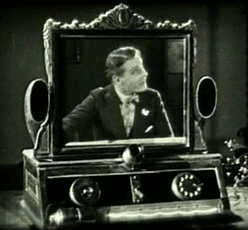

Reviews and articles: Variety, May 13, 1925; New York Times, May 12, 1925; American Cinematographer, Dec. 1924: 5–6, 22
http://www.imdb.com/title/tt0016478/
Super-Hooper-Dyne Lizzies
(1925, Mack Sennet, US) dir. Del Lord
US release: June 14, 1925
In this short Mack Sennett film, the daughter of the inventor of a radio-controlled automobile uses her "Radioscope" to signal Dad that she's run out of gas.

Reviews: Motion Picture News, June 13, 1925: 2968; Moving Picture World, June 13, 1925: 765
VIDEO: https://www.youtube.com/watch?v=tdFZTS8RZYc
http://www.imdb.com/title/tt0016375/
Metropolis
(1927, UFA, Germany) dir. Fritz Lang
Germany release: Jan. 10, 1927; US release: Mar. 13, 1927
Among the many futuristic elements featured in this science-fiction dystopia is a picture telephone that allows the ruler of the city to communicate with the manager of his underground machine rooms.
Reviews: Variety, Feb. 23 and Mar. 16, 1927; New York Times, Mar. 7, 1927
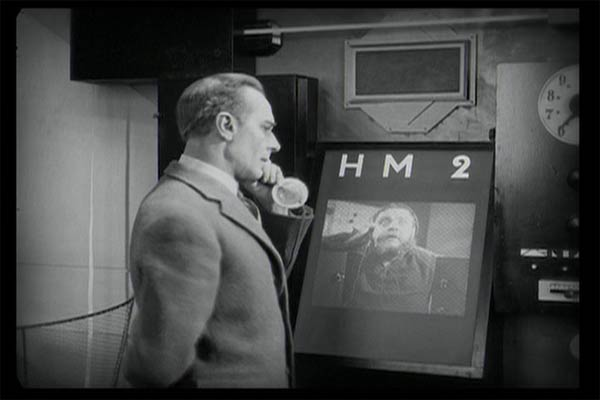
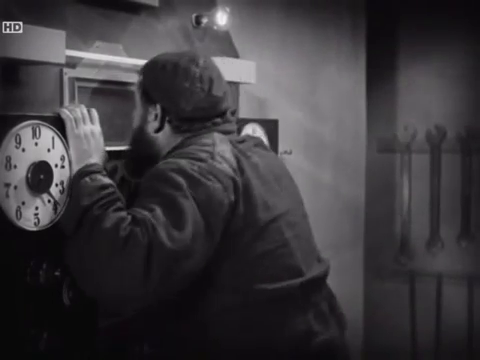
VIDEO: https://archive.org/details/MetropolisFritzLang1927Remastered
http://www.imdb.com/title/tt0017136/
The Thirteenth Hour
(1927, MGM, US) dir. Chester Franklin
US release: Oct. 13, 1927
Dark-house thriller starring the dog, Napoleon, and Lionel Barrymore. Barrymore has a closed-circuit television system that allows him to spy on the dog as it moves through various rooms of his mansion.
Reviews: Variety, Nov. 3, 1927; New York Times, Nov. 28, 1927
http://www.imdb.com/title/tt0018480/
The Third Eye
(1929, Graham-Wilcox Productions, UK) dir. Maclean Rogers
UK release: Jan. 1929
The plot involves bank robbers using a television apparatus in order to discover the safe combination. "The Third Eye [. . .] is said to contain a thrilling novelty appeal. The entire television process will be as part of the dramatic story" , Oct. 22, 1928: 3 Exhibitors Daily Review
http://www.imdb.com/title/tt0186616/
The Lone Wolf's Daughter
(1929, Columbia Pictures, US) dir. Albert S. Rogell
US release: Feb. 18, 1929
The Lone Wolf, a reformed criminal, foils an international jewel theft. Based on the character created by Louis Joseph Vance. "Television for the first time is used as a dramatic device to supply the unusual climax" Screenland, Jan. 1929: 76. Released as a part-talkie.
Reviews: Variety, Mar. 6, 1929; New York Times, Mar. 4, 1929; Motion Picture News, Mar. 9, 1929: 775

http://www.imdb.com/title/tt0020106/
Television George
(1929, Stern Brothers/Universal, US) dir. Francis Corby
US release: Feb. 24, 1929
Short comedy based on the cartoons of George McManus. "This ‘Let George Do It' comedy contains some good fun patterned after the usual ‘dumb' comedy style of its star, Sid Saylor, who does effective work as a gamboling husband kissing the girlies in a television broadcasting room. His wife awaiting him at home sees his performance through her receiving set and hurries to the station to pummel her guilty better half and a rough and tumble fight is the result" , May 11, 1929: 1646 Motion Picture News.
http://www.imdb.com/title/tt0324190/
High Treason
(1929, Gaumont-British, UK) dir. Maurice Elvey
US release: Mar. 25, 1929; UK release: Sep. 20, 1929 (sound version)
Set in 1940 on the eve of a world war, this futuristic drama features a visual telephone apparatus. "The televisor takes the place of the telephone, a combination of screen and loud speaker is fitted into office desk or home bureau, the appropriate wavelength is switched on, and conversations are carried on in full sight of each speaker. ‘Oh! that someone would invent something to enable me to touch you!' fervently exclaims the hero during one of these television conversations with the heroine" "A British Talkie," Sydney Morning Herald, Sep. 20, 1929: 10.

Reviews: Variety, Oct. 2, 1929; New York Times, Aug. 25, 1929; Motion Picture News, June 7, 1930
http://www.imdb.com/title/tt0018996/
The Vagabond Queen
(1929, British International Pictures, UK) dir. Géza von Bolváry
UK release: May 1929 (silent version); Aug. 1930 (sound version)
In order to save her from assassination, a young woman is asked to act as the double of the princess of a fictional European country. She agrees to do so because it would allow her to help finance her boyfriend's invention of television.
http://www.bfi.org.uk/films-tv-people/4ce2b7824a40d
Review: Variety, Sep. 3, 1930
http://www.imdb.com/title/tt0019724/
Uncle Si and the Sirens
(circa 1928–30, CineArt Productions, US)
Release: late 1920s [?]
A stereotypical rube constructs a television set at home. At first he tunes in a temperance lecturer, but later switches to images of naked women in exotic locations. His wife discovers him and smashes the apparatus with a broom. CineArt produced films directly for the new 16mm market.

Elstree Calling
(1930, British Intl., UK) dirs. André Charlot, Jack Hulbert, Paul Murray, and Alfred Hitchcock
UK release: Feb. 6, 1930
A British answer to the American Hollywood Revue, the various musical vignettes in this film are tied together loosely in a storyline about a television broadcast of a show. Alfred Hitchcock reportedly was responsible for the general direction.


Reviews: Variety, Feb. 26, 1930; New York Times, Mar. 9, 1930
http://www.imdb.com/title/tt0020852
Hello Television
(1930, Mack Sennett Comedies, US) dir. Leslie Pearce
US release: Aug. 17, 1930
In this short Mack Sennett comedy, "Andy's daughter Ann meets Nick over her television phone and falls in love with him despite Andy's intention to have her marry a rich Stedman" (Brent E. Walker, Mack Sennett's Fun Factory, 438).

Reviews and articles: Motion Picture News, Aug. 23, 1930; Film Daily, Aug. 24, 1930; Exhibitors Herald World, Aug. 30, 1930
http://www.imdb.com/title/tt0020964/
The Golf Specialist
(1930, RKO, US) dir. Monte Brice
US release: Aug. 27, 1930
In this W. C. Fields short, the comedian approaches a hotel clerk and inquires, "Any telegrams? Cablegrams? Radio? Television?"
Review: Motion Picture News, July 5, 1930
VIDEO: https://www.youtube.com/watch?v=wfm8gR12hA4
http://www.imdb.com/title/tt0020927/
Believe It Or Not no. 4
(1930, Warner Bros., US) dir. Arthur Hurley
US release: Sep. 5, 1930
Vitaphone short. As part of experiments with television, the Ripley's Believe It or Not material is projected "into the homes of the nation." The film scenes alternate between the presenter in the studio and a family watching him on a television set.
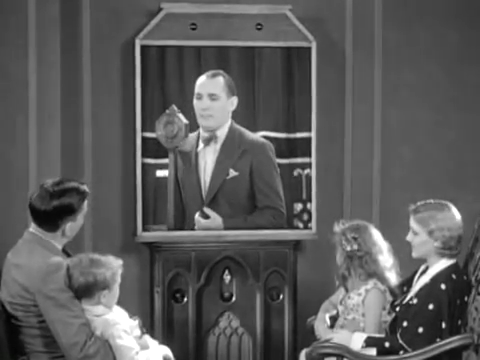
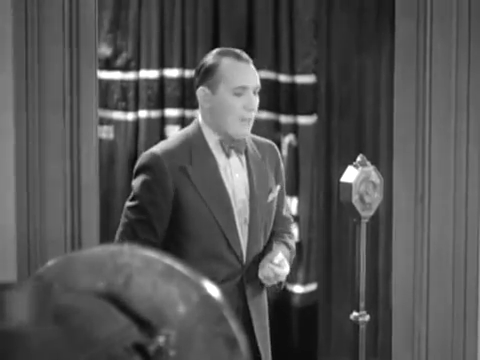
Review: Motion Picture News, Nov. 1, 1930
http://www.imdb.com/title/tt0309353/
Just Imagine
(1930, Fox, US) dir. David Butler
US release: Nov. 23, 1930
Science-fiction musical comedy, set in a futuristic New York in 1980, features the use of a picture telephone.

Reviews: Variety, Nov. 26, 1930; New York Times, Nov. 22, 1930
VIDEO: https://www.youtube.com/watch?v=eldqx1MChyc
http://www.imdb.com/title/tt0021016
Magie moderne / Modern Magic
(1931, Paramount Pictures, France) dir. Dimitri Buchowetzki
France release: 1931
A production of the Paramount studios in France, this film tells the story of a young television inventor whose sponsor proves to be a dishonest businessman who tries to appropriate the invention. This French-speaking film was shot in seven other versions, using the same sets and directors but crews from different nationalities (see following entries).
Review: Les Spectacles d'Alger, May 27, 1931
http://www.unifrance.org/film/12592/magie-moderne
http://www.imdb.com/title/tt0191262/
Trådlöst och kärleksfullt / Wireless and Loving
(1931, Paramount Pictures, France) dir. Frederick Lindh
Sweden release: Apr. 1932
Swedish version of Magie moderne shot on the same set in France. Starring Paul van der Osten, Karin Swanström, and Margita Alfven.
http://www.sfi.se/sv/svensk-filmdatabas/Item/?itemid=3688&type=MOVIE&iv=Story
http://www.imdb.com/title/tt0022507/
Televisione / Television
(1931, Paramount Pictures, France) dir. Charles de Rocheford
Italy release: Sept. 1931
Italian version of Magie moderne shot on the same set in France. Also called La canzone del mondo. Starring Anna Maria Dossena, Silvio Orsini, and Cesare Zoppetti.
http://www.imdb.com/title/tt0193556/
De sensatie der toekomst / The Thrill of the Future
(1931, Paramount Pictures, France) dirs. Dimitri Buchowetzki and Jack Salvatori
Holland release: Oct. 1931
Dutch version of Magie moderne shot on the same set in France. Starring Dolly Bouwmeester, Rolant Varno, and Marie van Westerhoven.
http://www.imdb.com/title/tt0193491/
Televiziune / Television
(1931, Paramount Pictures, France) dirs. Phil D'Esco and Jack Salvatori
Romanian version of Magie moderne shot on the same set in France. Starring Mircea Balaban, Pola Illéry, and Sofica Ionescu.
http://www.imdb.com/title/tt0141892/
Svet bez hranic / A World without Borders
(1931, Paramount Pictures, France) dir. Julius Lébl
Czech version of Magie moderne shot on the same set in France. Starring Theodor Pistek, Mána Zenísková, and Marie Ptáková.
http://www.imdb.com/title/tt0193544/
Swiat bez granic / A World without Borders
(1931, Paramount Pictures, France) dir. Ryszard Ordynski
Polish version of Magie moderne shot on the same set in France. Starring Adam Brodzisz, Maria Dabrowska, and Andrzej Nalecz.
http://www.imdb.com/title/tt0193546/
Welt ohne Grezen / A World without Borders
(1931, Paramount Pictures, France) dir. Eugen Thiele
German version of Magie moderne shot on the same set in France. Released in Berlin under the title Television. Starring Anni Ann, Ida Peery, and Fred Döderlein.
Once a Sinner
(1931, Fox, US) dir. Guthrie McClintic
US release: Jan. 25, 1931
Love-triangle drama starring Joel McCrea as a small-town inventor of a radio device that allows you to see what other people are doing if they have a corresponding transmitter. His life changes when the machine is taken up by investors. One scene features the machine in his workshop, though it is never demonstrated onscreen.
Reviews and articles: Variety, Jan. 21, 1931; New York Times, Jan. 17, 1931; Photoplay, Mar. 1931: 177
http://www.imdb.com/title/tt0021211
The Public Enemy
(1931, Warner Bros., US) dir. William Wellman
US release: Apr. 23, 1931
In this classic gangster film, one of the newspaper pages that is briefly shown onscreen includes an item about development in television.

Review: New York Times, Apr. 24, 1931
http://www.imdb.com/title/tt0022286/
The Voice of Hollywood (second season, no. 1)
(1931, Tiffany, US) dir. [?]
US release: July 5, 1931
An episode in a series of radio-themed short musical revues, "made to look as though the pictures were being televised from a television studio" (Film Daily, Apr. 12, 1931: 18). This episode, in which Chester Conklin presents a cake recipe on television, "employs a television device cleverly, with a gag worked all through the various shots [of celebrities]" (Film Daily, Aug. 23, 1931).
Review: Film Daily, Aug. 23, 1931: 19
The Voice of Hollywood (second season, no. 6)
(1931–32, Tiffany, US) dir. [?]
US release: Sep. 13, 1931
In this episode in a series of short radio-themed musical revues, John Boles appears as a television master of ceremonies and introduces Hollywood stars in guest appearances.
Review: Film Daily, Oct. 11, 1931: 5
The Voice of Hollywood (second season, no. 13)
(1931–32, Tiffany, US) dir. [?]
US release: Jan. 1932
In this episode in a series of short radio-themed musical revues, a television set shows Jack Dempsey and his wife on a fishing trip.
Review: Film Daily, Jan. 17, 1932: 10
The Robot
(1932, Fleischer Studios/Paramount, US) dir. Dave Fleischer
US release: Feb. 5, 1932
Short cartoon in the "Bimbo" series, in which the mechanic-inventor dog calls his girlfriend on the television, and images of her taking a bath appear on his screen to her great embarrassment.
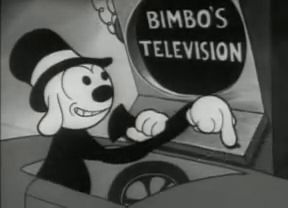

Review: Variety, Mar. 1, 1932
VIDEO: https://www.youtube.com/watch?v=GIYGPr539Ss
http://www.imdb.com/title/tt0023408/
The Musical Doctor
(1932, Paramount Pictures, US) dir. Ray Cozine
US release: Oct. 28, 1932
Musical short featuring Rudy Vallee in the role of a doctor who treats his patients by singing "Keep a Little Song Handy" through a television system.
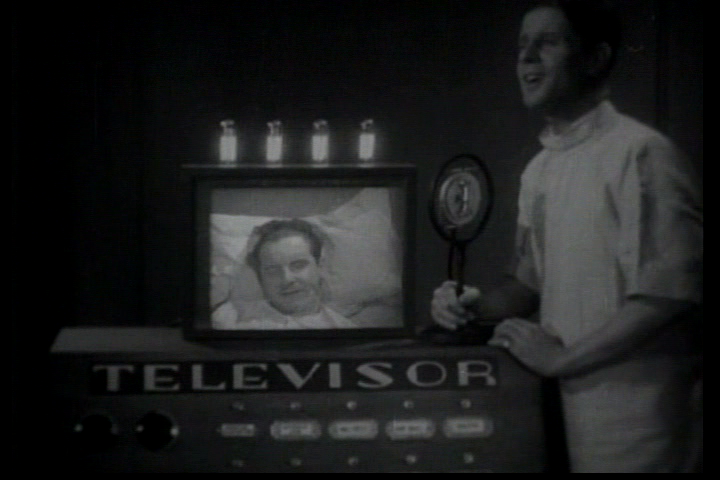
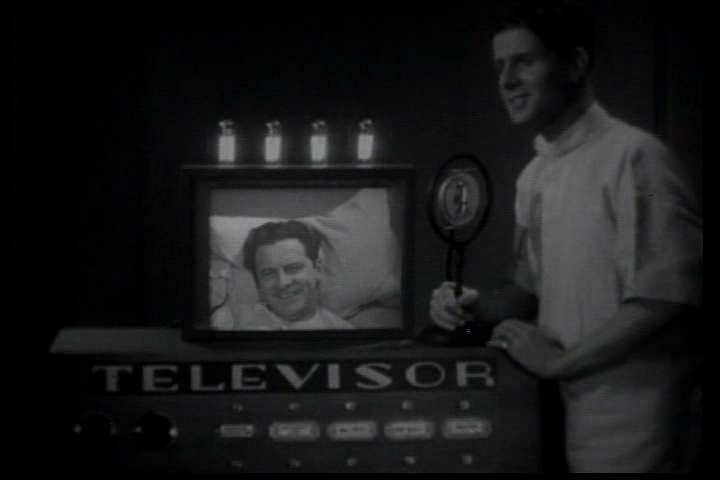
Review: Variety, Sep. 20, 1932
http://www.imdb.com/title/tt0285760/
Hyakunengo no aruhi / A Day After a Hundred Years
(1933, Japan) dir. Shigeji Ogino
In this science-fiction animation short, set in Tokyo in the year 2032, a magic television set shows the spirit of the protagonist images of world events that occurred after his death.
http://www.cinetecadelfriuli.org/gcm/ed_precedenti/screenings_recorden.php?ID=6795
http://www.imdb.com/title/tt0422442
Thought for Food
(1933, Jam Handy Picture Service, US) dir. John Freese
Sponsored short film for the Kroger Food Foundation, depicting a television presenter from a station in Cincinnati addressing an audience of homemakers and describing for them the facilities and quality control at the laboratories of Kroger Food.

https://archive.org/details/0539_Thought_for_Food
VIDEO: https://www.youtube.com/watch?v=d-_nPnSkd6E
The Television Follies
(1933, English Films, UK) dir. Geoffrey Benstead
"A revue musical in which a Lancashire family watch a series of performers on their television set" (John Mundy, The British Musical Film, 36).
http://www.bfi.org.uk/films-tv-people/4ce2b777dcaff
http://www.imdb.com/title/tt0465086/
Men Must Fight
(1933, MGM., US) dir. Edgar Selwyn
US release: Feb. 17, 1933
Much like High Treason, which was made four years earlier, this film is set in 1940 on the eve of a world war. A peace activist's antiwar rally is televised into homes (and saloons), and the citizens communicate via picture telephone.
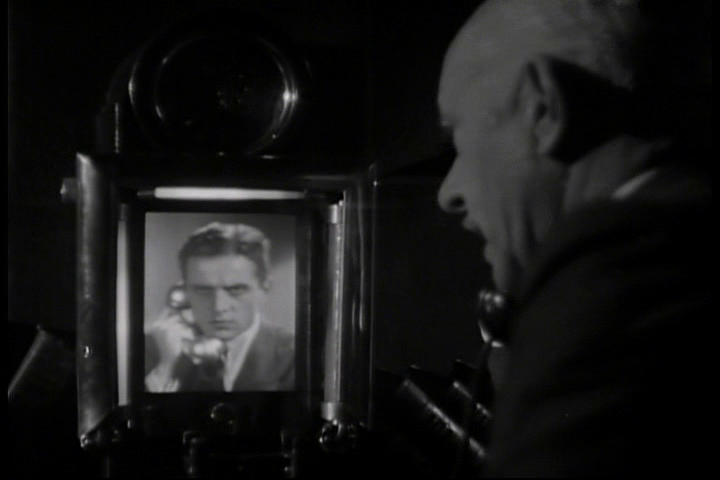
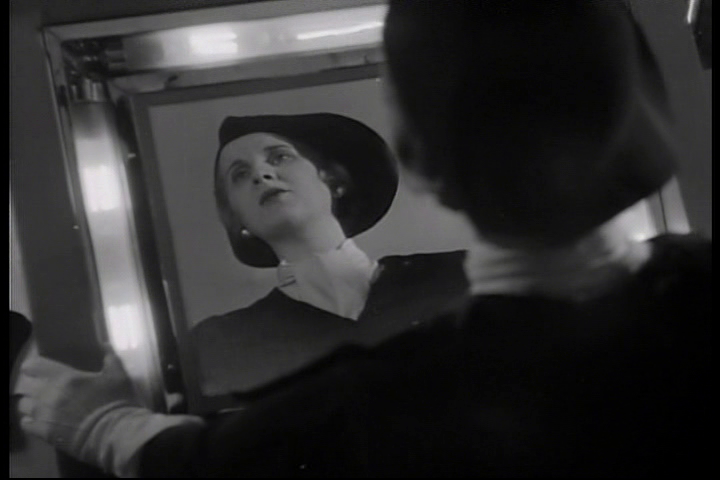
Reviews: Variety, Mar. 14, 1933; New York Times, Mar. 11, 1933
http://www.imdb.com/title/tt0024325
Whispering Shadow
(1933, Mascot Pictures, US) dirs. Colbert Clark and Albert Herman
US release: Apr. 18, 1933
Serial, starring Bela Lugosi, about an arch-criminal who controls his gang by means of wireless and television technologies.
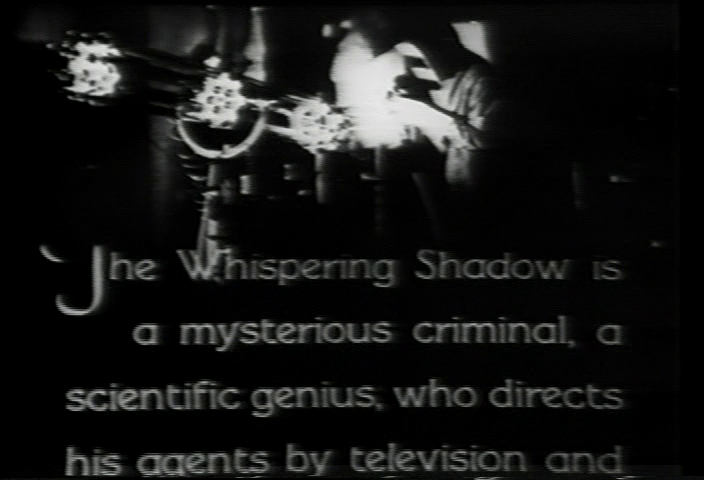
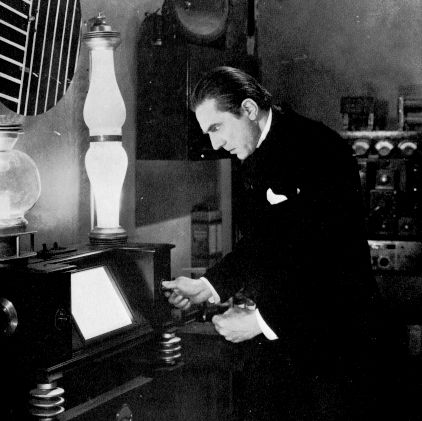
Review: Motion Picture Herald, Feb. 24, 1934
VIDEO: https://www.youtube.com/watch?v=8KsEjF40q1g
http://www.imdb.com/title/tt0024768/
Rambling 'Round Radio Row no. 7
(1933, Warner Bros., US) dir. [?]
US release: June 1933
Vitaphone short featuring a crystal ball described as a "crystal set" that allows not only hearing radio programs, but also seeing them. The magical object is then used in a television-like fashion to present a series of short songs.
Review: Film Daily, July 29, 1933
VIDEO: http://www.dailymotion.com/video/xr8su_rambling-round-radio-row_music
http://www.imdb.com/title/tt0144570/
International House
(1933, Paramount, US) dir. Edward Sutherland
US release: June 2, 1933
Promoted as "the Grand Hotel of comedy," this W. C. Fields vehicle revolves around an international race to bid on the new invention of the "radioscope," an audiovisual broadcasting apparatus invented by a Chinese scientist.
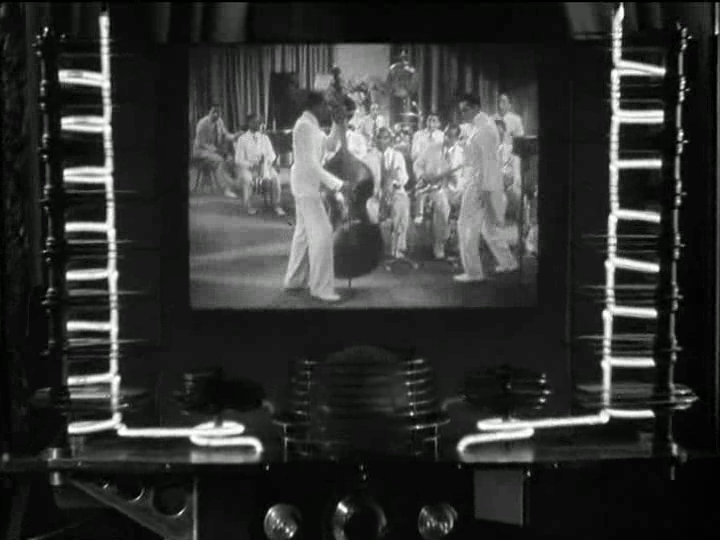
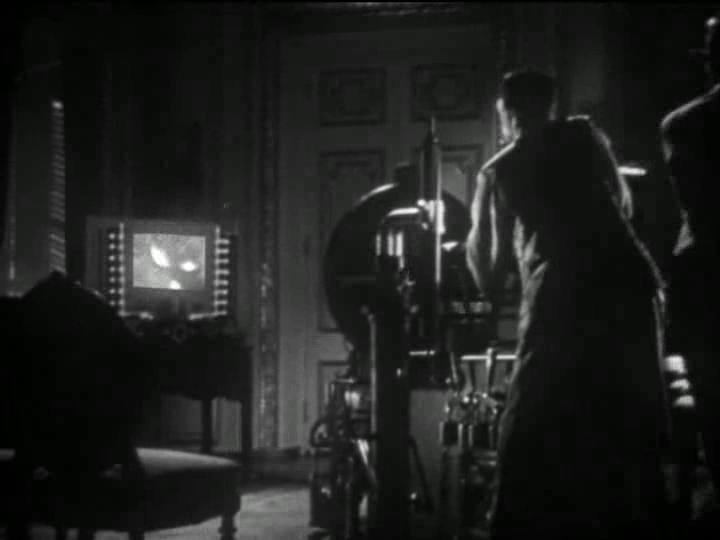
Reviews: Variety, May 30, 1933; Motion Picture Herald, May 20, 1933
http://www.imdb.com/title/tt0024183/
How to Break 90 no. 2 – Position and Backswing
(1933, Warner Bros., US) dir. George E. Marshall
US release: June 10, 1933
In this episode from a series of short golf instruction films starring Bobby Jones, the golf champion appears on a television set in a program broadcast over station KFWD (which at the time was actually a Warner Bros. radio station in Hollywood).
Review: Variety, May 16, 1933
http://www.imdb.com/title/tt0194021/
College Coach
(1933, Warner Bros., US) dir. William Wellman
US release: Nov. 4, 1933
The opening scene of this football drama shows a meeting of college professors, with the participants listening to a football game on the radio. In the last moments of the game, an image of the match is shown on top of the radio apparatus—arguably intending to simulate a television broadcast.

Reviews: Variety, Nov. 14, 1933; New York Times, Nov. 11, 1933
http://www.imdb.com/title/tt0023899/
My Lips Betray
(1933, Fox, US) dir. John Blystone
US release: Nov. 10, 1933
In the opening of this musical romance set in an imaginary European country, a young cabaret singer, played by Lillian Harvey, is offered a ride in the king's car. The car is equipped with a television set that shows a Mickey Mouse cartoon, Ye Olden Days, but its original soundtrack has been replaced by Mickey (?) singing "I'll Build a Nest," one of the songs from this film.
Reviews: Variety, Nov. 7, 1933; New York Times, Nov. 4, 1933; Film Daily, Nov. 4, 1933: 4
Die welt ohne maske / The World Unmasked
(1934, Ariel, Germany) dir. Harry Piel
Germany release: Mar. 9, 1934
Science-fiction thriller about an inventor of a television technology that not only broadcasts audiovisual materials, but also has X-ray–like powers to penetrate through obstacles.
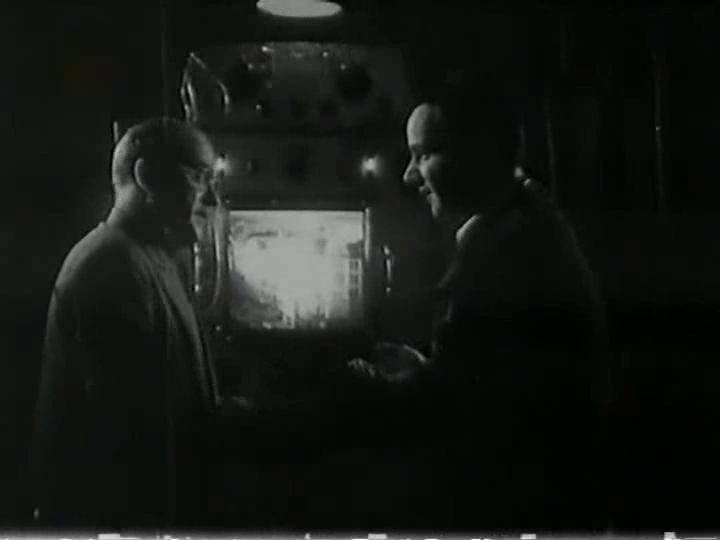
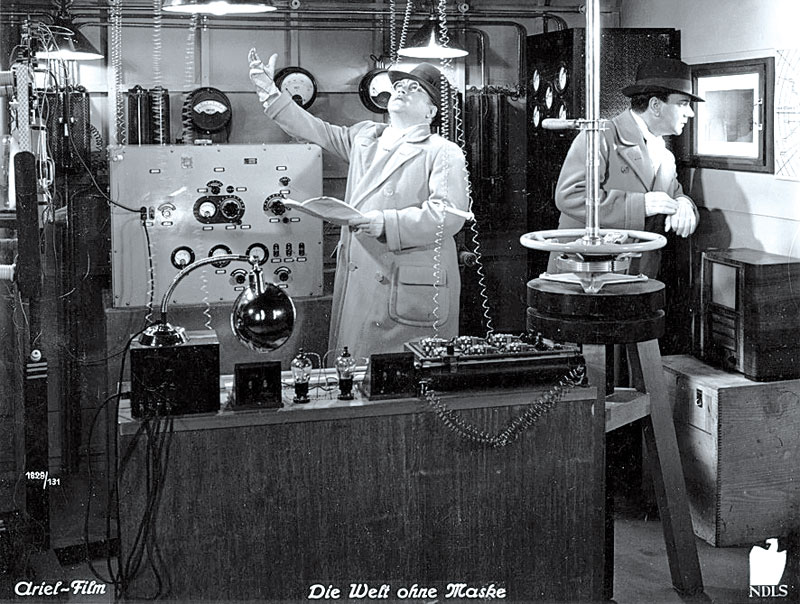
Reviews and articles: Filmkritik, Mar. 18, 1934; Der Kinematograph Berlin 50 (1934); Die Filmwoche, Mar. 21, 1934 (cited in Florentine Strzelczyk, "Innocent Action and Splendid Spectacle:
Fascism and Entertainment in Harry Piel's Movie Die Welt ohne Maske (1934)," German Quarterly 77.4 [Autumn 2004]: 427–42)
VIDEO: https://www.youtube.com/watch?v=r3CVGVy4Yto
http://www.imdb.com/title/tt0025968/
Mystery Liner
(1934, Monogram Pictures, US) dir. William Nigh
US release: Mar. 15, 1934
This murder mystery, set on a radio-controlled ship, features a visual telecommunication device that transmits handwritten messages ship-to-shore.

Reviews: Variety, Apr. 10, 1934; Photoplay, Apr. 1934: 90, 104.
VIDEO: https://www.youtube.com/watch?v=Y1QBi0J2fG0
http://www.imdb.com/title/tt0025543/
The Stolen Melody
(1934, Warner Bros., US) dir. Joseph Henabery
US release: May 1934
Vitaphone short featuring "a machine (similar to television) that discovers the origins of songs [and] shows many of the songs being performed" (Roy Liebman, Vitaphone Films: A Catalogue of the Features and Shorts, 111).
http://www.imdb.com/title/tt1630065/
Radio Parade of 1935
(1934, Associated British Pictures, UK) dir. Arthur B. Woods
UK release: Dec. 12, 1934
British musical comedy about a newly appointed director of a broadcasting company who tries to enlist new talent for a program he intends to air on television, in color, on screens erected in main streets. Shot partly in color, the film was released in the US as Radio Follies.
Reviews: Motion Picture Daily, Nov. 28, 1934; Motion Picture Herald, Jan. 12, 1935
http://www.imdb.com/title/tt0025698
The Lost City
(1935, Sherman S. Krellberg, US) dir. Harry Revier
US release: Feb. 14, 1935 (feature film version); March 6, 1936 (serial version)
Science-fiction adventure about a secret city in the jungle governed by a mad scientist. Among other technological novelties, the mad scientist uses a television surveillance system.

Review: Harrison's Report, Apr. 6, 1935
VIDEO: https://www.youtube.com/watch?v=3iEqF9QMsfY
http://www.imdb.com/title/tt0026216/ http://www.imdb.com/title/tt0026652/
The Phantom Empire
(1935, Mascot Pictures, US) dirs. Otto Brower and B. Reeves Eason
US release: Feb. 23, 1935
Gene Autry western/musical/science-fiction serial set in a futuristic underground empire located beneath the singing cowboy's Radio Ranch. Among many other technological novelties, the people of the underground empire use a "master television" surveillance system.
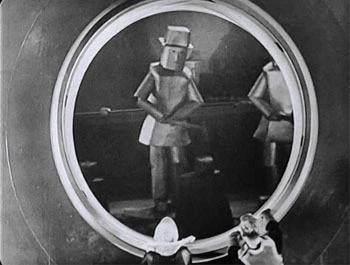
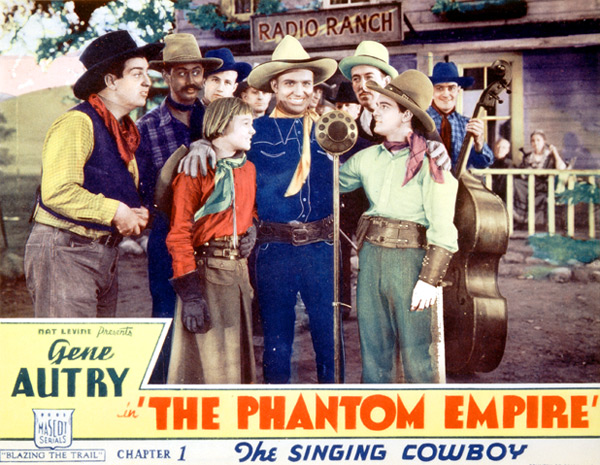
VIDEO: https://archive.org/details/phantom_empire_chapter_1
http://www.imdb.com/title/tt0026867/
The Miracle Rider
(1935, Mascot Pictures, US) dirs. B. Reeves Eason and Armand Schaefer
US release: Apr. 12, 1935
Western serial starring Tom Mix, in his last major role, as a Texas Ranger who fights to stop a gang of industrialists from driving off a local Native American group in order to mine their land. The antagonists in this film possess screen technologies for surveillance and transmission of textual messages.
VIDEO: https://www.youtube.com/watch?v=kjR765SHJWU
http://www.imdb.com/title/tt0026720/
Werewolf of London
(1935, Universal Pictures, US) dir. Stuart Walker
US release: May 13, 1935
The laboratory of the scientist (and soon to be wolf man) is equipped with a closed-circuit television.
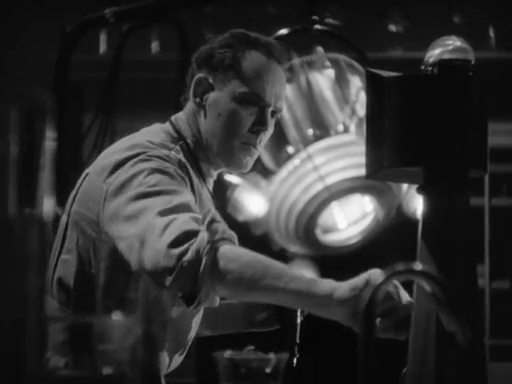
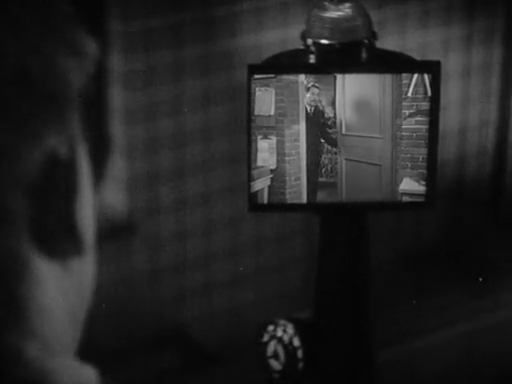
Reviews: Variety, May 15, 1935; New York Times, May 10, 1935
http://www.imdb.com/title/tt0027194/
The Big Broadcast of 1936
(1935, Paramount, US) dir. Norman Taurog
US release: Sept. 20, 1935
In this entry in the Big Broadcast series of musical comedies, the plotline that connects the various acts concerns a struggling radio station owner's attempts to use the radio eye, "a nutty television contraption [. . .] which can pick up any event and also send" (Variety, Sept. 18, 1935).
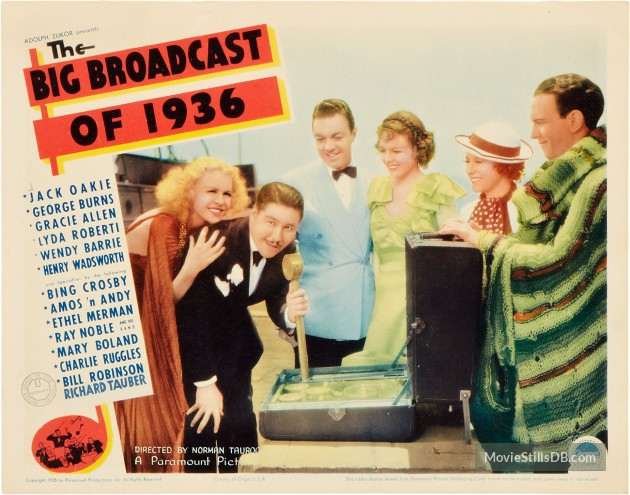
Reviews: Variety, Sept. 18, 1935; New York Times, Sept. 16, 1935; Harrison's Report, Sep. 21, 1935
http://www.imdb.com/title/tt0026113/
Murder by Television
(1935, Cameo Pictures, US) dir. Clifford Sanforth
US release: Oct. 25, 1935
The festive inaugural demonstration of a newly invented television technology ends when the inventor suddenly dies on camera. The investigation that follows reveals that the murderer used an electrical apparatus to turn the television apparatus into a lethal death ray. Shows an actual mechanical television flying spot scanner.
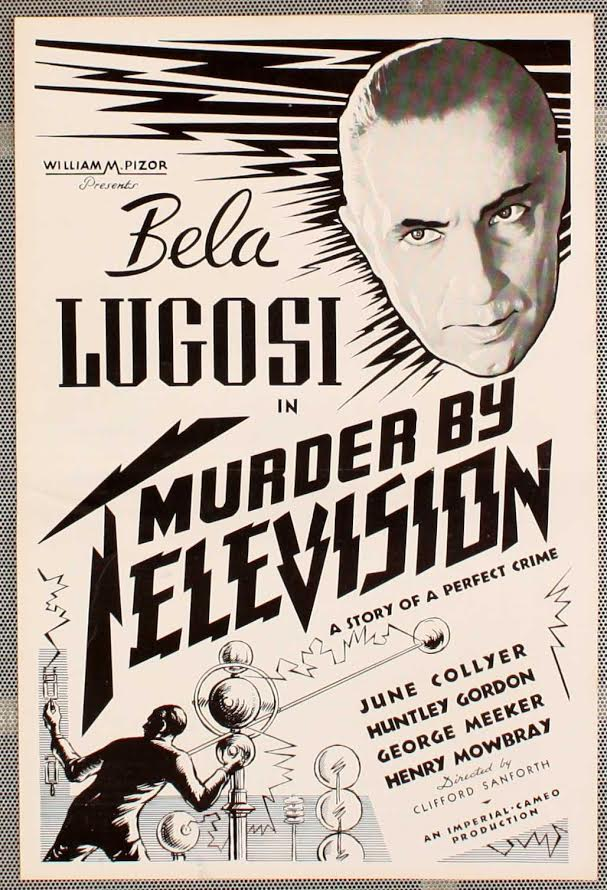
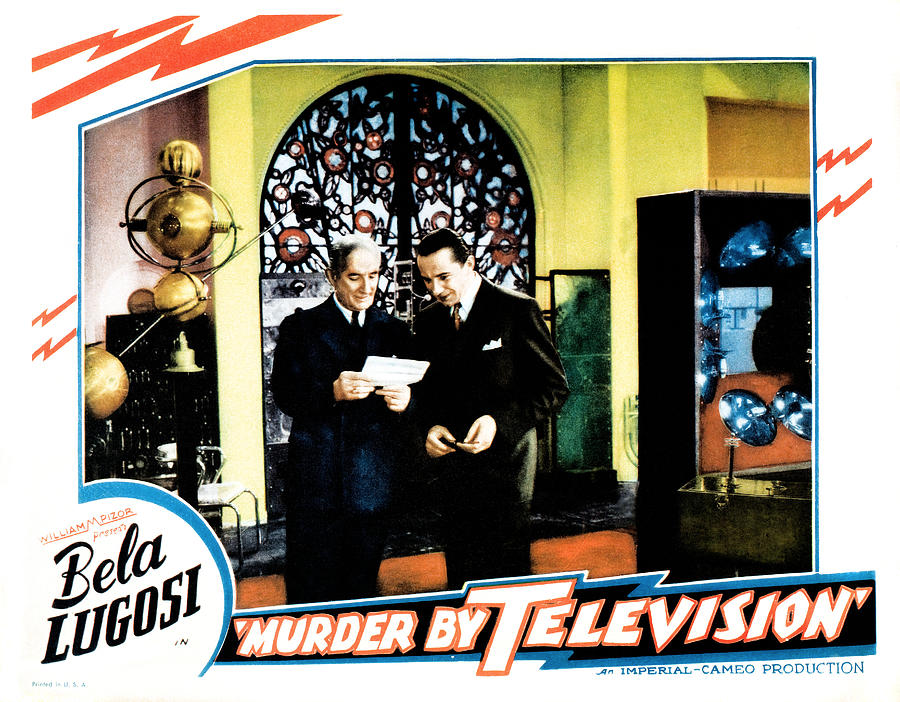
Review: Motion Picture Daily, Sep. 4, 1935
VIDEO: https://www.youtube.com/watch?v=oetP5BY59tc
http://www.imdb.com/title/tt0026740/
The Tunnel
(1935, Gaumont British, UK) dir. Maurice Elvey
US release: Oct. 27, 1935; UK release: Nov. 1935
British adaptation of the Bernhard Kellermann novel that was also made in Germany in 1913 and 1933. Like the first version, this film features large-screen televisions that are used for making public announcements about the project of digging the undersea tunnel, as well a visual telephony system. Released in the US as Transatlantic Tunnel.


Reviews: Variety, Oct. 30, 1935; New York Times, Oct. 28, 1935
VIDEO: https://www.youtube.com/watch?v=julRpfEZ6AM
http://www.imdb.com/title/tt0027131/
Te Quiero con Locura / Rest Cure
(1935, Fox, US) dir. John Boland
US release: Nov. 1, 1935
This Spanish-language film shot in Los Angeles features a couple who are observed by psychiatrists via closed-circuit television in order to determine whether they are insane.
Review: New York Times, Nov. 4, 1935
http://www.imdb.com/title/tt0146924/
Thanks a Million
(1935, Twentieth Century Fox, US) dir. Roy Del Ruth
US release: Nov. 15, 1935
This musical comedy references television, though not showing it, as one of the characters reads Variety on a bus and proclaims—years before television broadcasts started—that radio and television are here to stay.
Review: Variety, Nov. 20, 1935
http://www.imdb.com/title/tt0027088/
The Fighting Marines
(1935, Mascot Pictures, US) dirs. B. Reeves Eason and Joseph Kane
US release: Nov. 23, 1935
Adventure serial about US Marines' struggle against a mad scientist. The antagonist communicates with his agents through an unusual two-way television device that requires wearing a headset to operate.
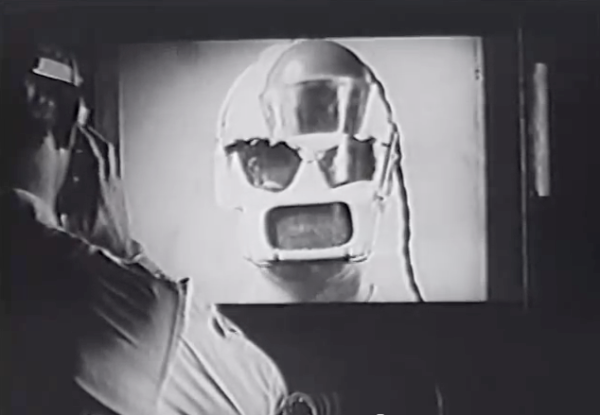

VIDEO: https://www.youtube.com/watch?v=-oT7Qpp7zU8
http://www.imdb.com/title/tt0026352/
Shadow of Chinatown
(1936, Victory Pictures, US) dir. Robert Hill
US release: Oct. 10, 1936
B-thriller released both as a fifteen-episode serial and as a feature film, starring Bela Lugosi as a scientist and inventor who is hired by criminals to put Chinese traders out of business. Among the inventions he uses is a television audiovisual surveillance system.
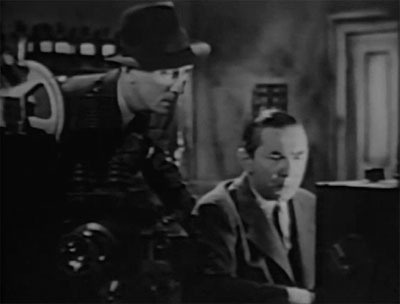
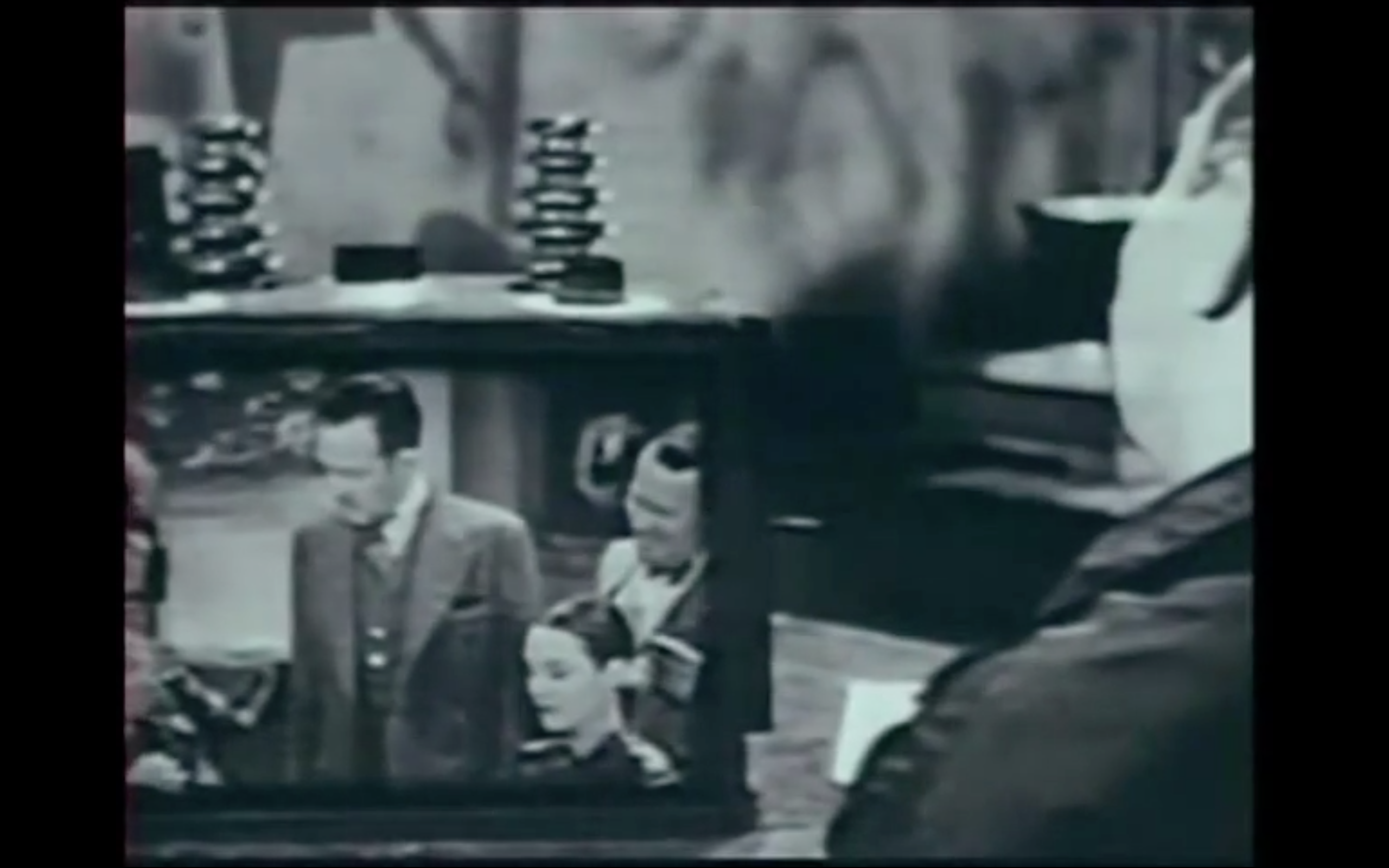
VIDEO: https://www.youtube.com/watch?v=Seo6wxgWfiM
http://www.imdb.com/title/tt0028241
http://www.imdb.com/title/tt0126659/
Kosmicheskiy reys / The Cosmic Voyage
(1936, Mosfilm, USSR) dir. Vasily Zhuravlyov
USSR release: Jan. 21, 1936
In this Soviet space adventure, television screens facilitate communication between Earth and a spaceship heading to the moon.
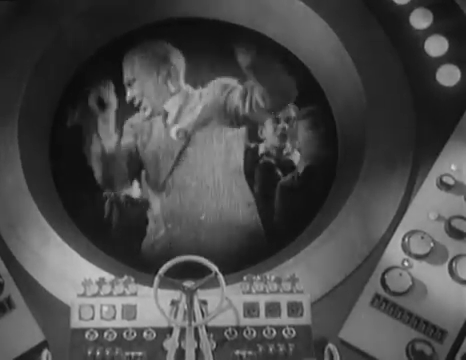
VIDEO: https://www.youtube.com/watch?v=5LWi2Iv9PmQ
http://www.imdb.com/title/tt0252612/
Things to Come
(1936, London Film, UK) dir. William Cameron Menzies
UK release: Feb. 2, 1936; US release: Apr. 17, 1936
"A new story based on material contained in his book, The Shape of Things to Come," this big-budget H. G. Wells science-fiction film depicts the world of the mid-21st century. It features both domestic television apparatus (described in the script as "a piece of apparatus on which pictures appear") and a "gigantic screen" version for public display.
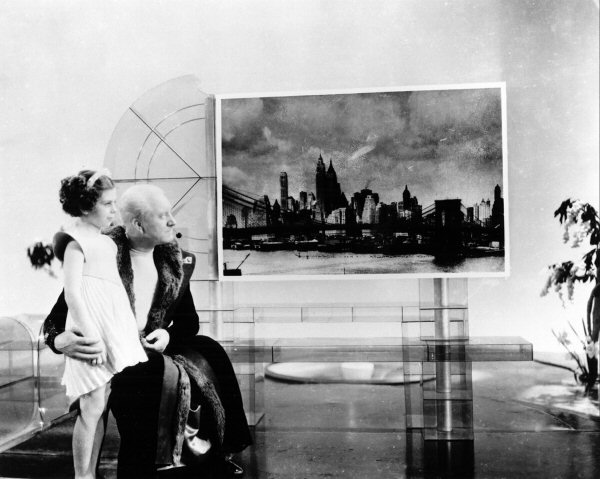
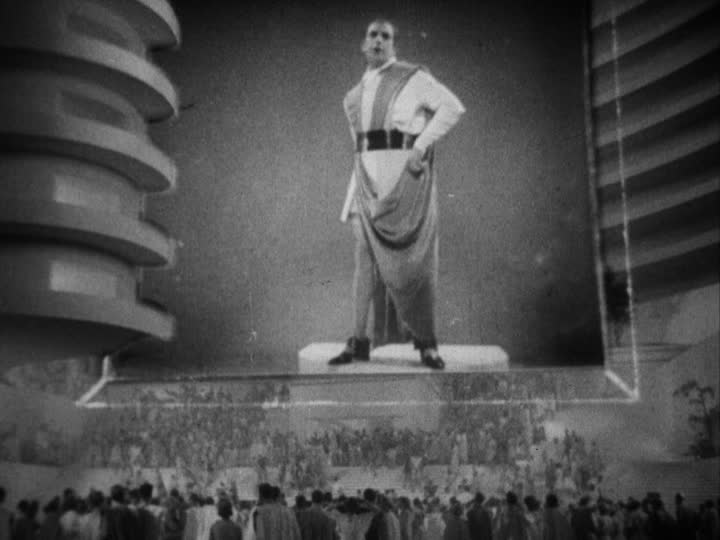
Reviews: Variety, Mar. 4 and Apr. 22, 1936; New York Times, Apr. 18, 1936
VIDEO: https://www.youtube.com/watch?v=kn76zoYjr4k
http://www.imdb.com/title/tt0028358
Modern Times
(1936, United Artists, US) dir. Charlie Chaplin
US release: Feb. 21, 1936
During the famous factory sequence in this Chaplin comedy, the president of the Electro Steel Corp. uses closed-circuit television to spy on his workers, give orders, and even rush the tramp out of the toilet to resume his work.
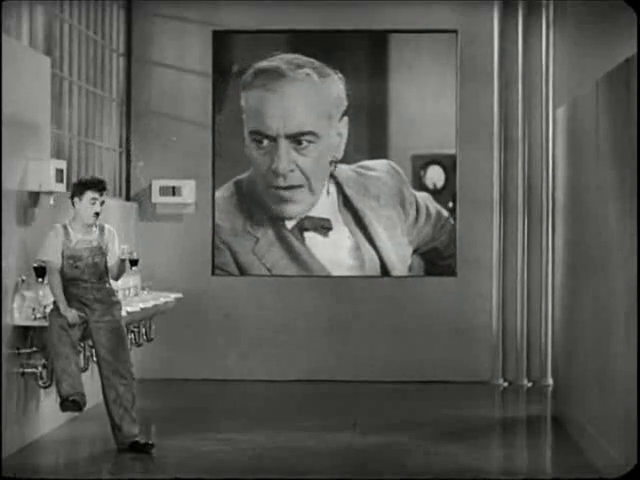
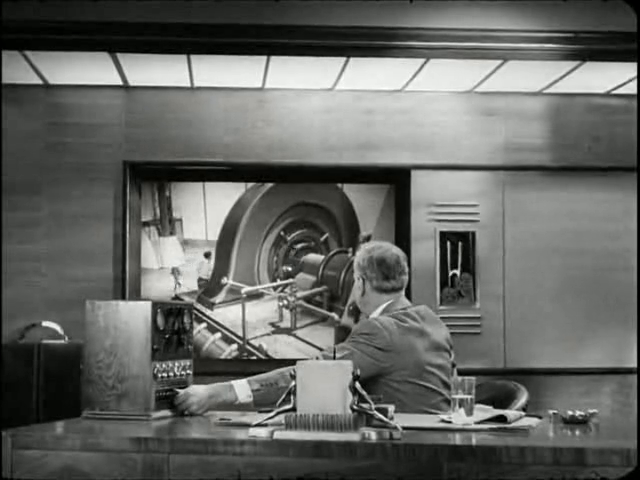
Reviews: Variety, Feb. 12, 1936; New York Times, Feb. 6, 1936
http://www.imdb.com/title/tt0027977/
Flash Gordon
(1936, Universal Pictures, US) dir. Frederick Stephani
US release: Apr. 6, 1936
Science-fiction serial, also released as a feature film, about the space adventures of the comic-strip hero. Flash's rival, Emperor Ming the Merciless, is depicted using television devices both as a security system against aerial attacks and for the transmission of images from an exotic wedding ceremony.
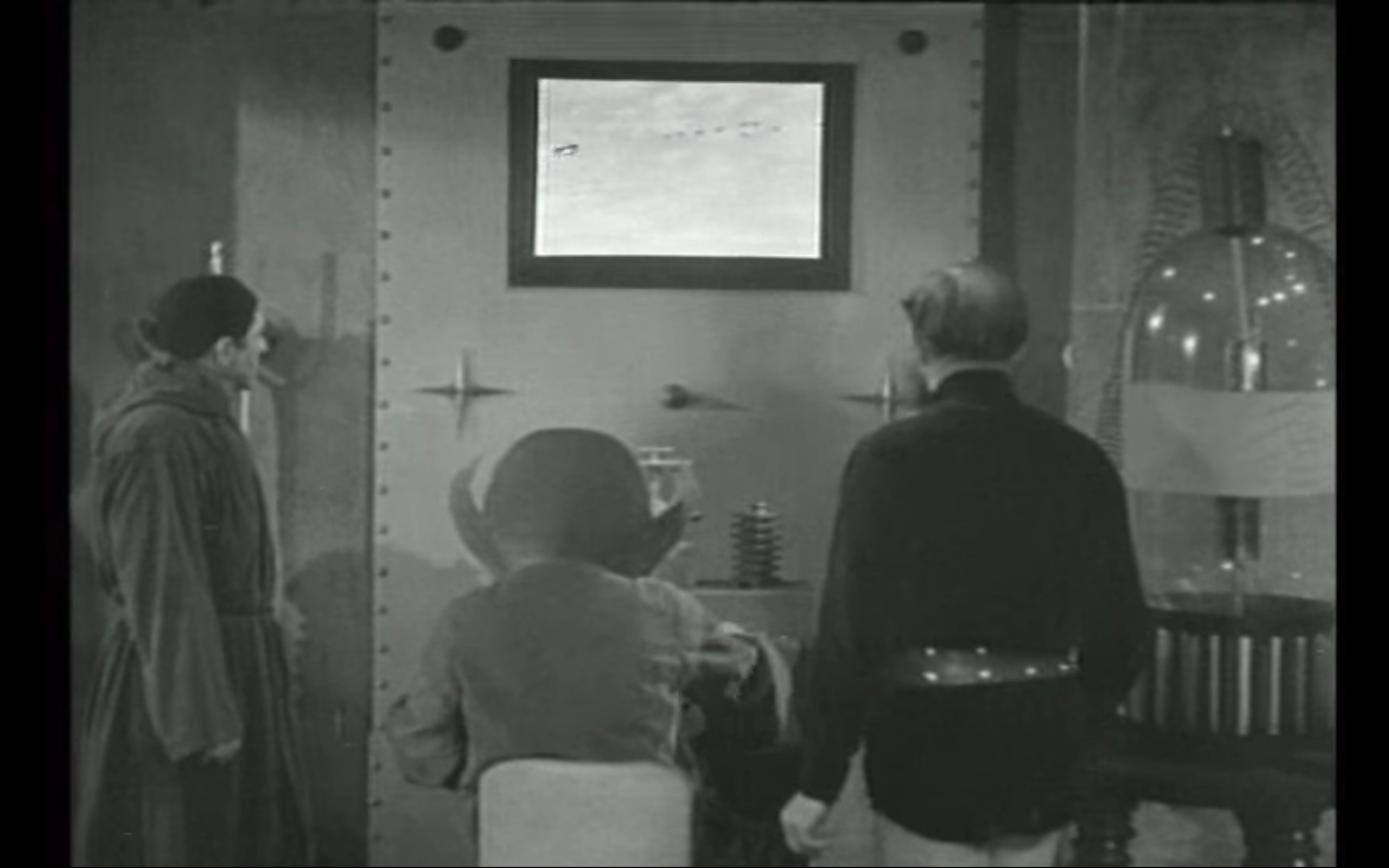
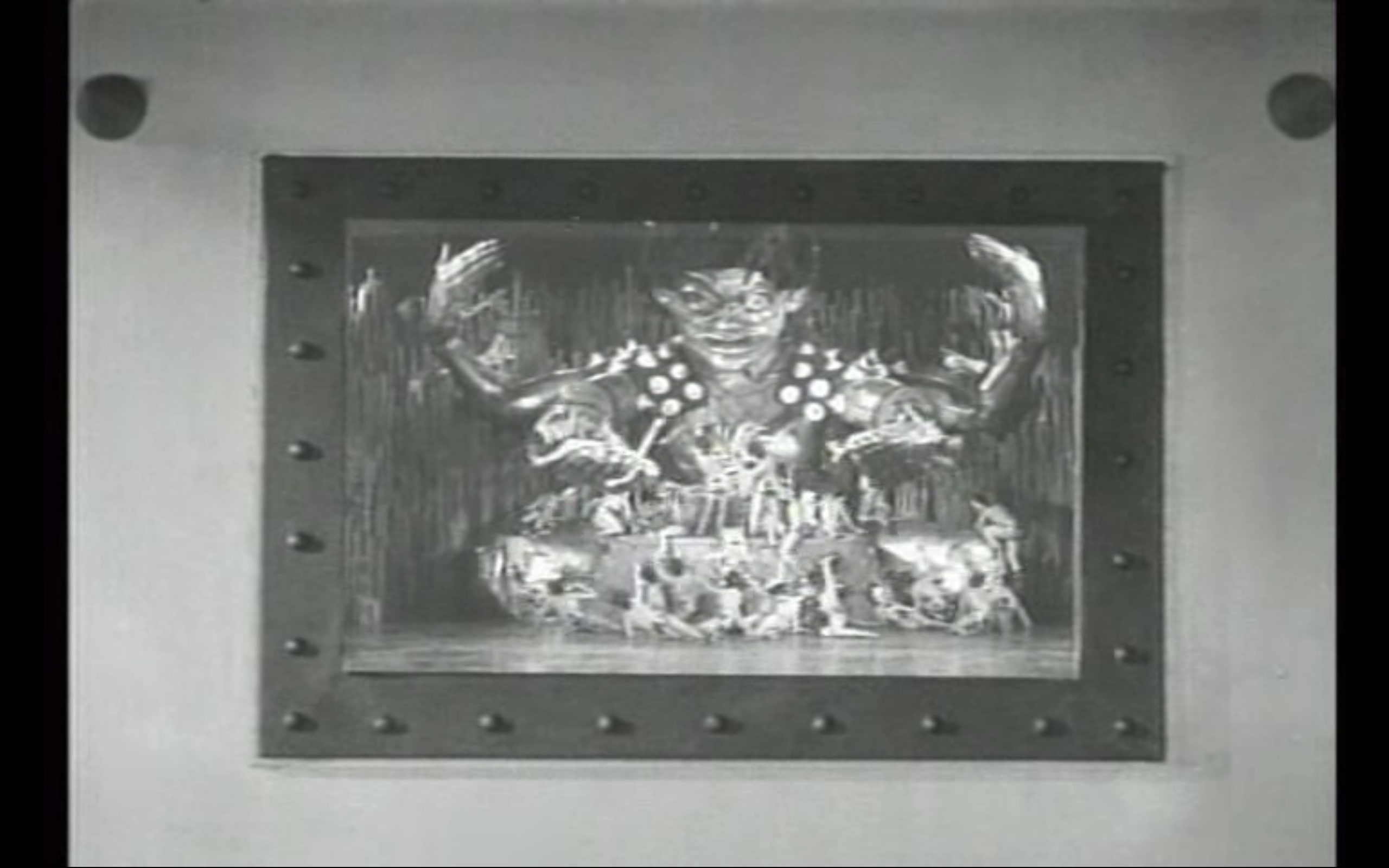
Reviews: Variety, Mar. 11, 1936; Motion Picture Herald, Mar. 14, 1936
VIDEO: https://www.youtube.com/watch?v=K5MD9cwpyqY
http://www.imdb.com/title/tt0027623
The Amazing Exploits of the Clutching Hand
(1936, Weiss Productions, US) dir. Albert Herman
US release: Apr. 18, 1936
In this mystery serial, the eponymous villain goes after a secret formula for artificial gold, and communicates with his henchmen and his extortion victims by means of a two-way television.

Review: Motion Picture Herald, May 23, 1936
VIDEO: https://www.youtube.com/watch?v=IeH84m--T9Q
http://www.imdb.com/title/tt0027452/
The Singing Cowboy
(1936, Republic Pictures, US) dir. Mack Wright
US release: May 11, 1936
Musical western features Gene Autry and a band of "television troubadours" touring across the country and broadcasting live remotes. Their sponsor is a manufacturer of "cowboy coffee." Curiously, the film does not depict any cameras or other television broadcasting apparatus other than a peculiar antenna. Audiences view the programs on large-screen receivers. Not a work of science fiction, this is the first American film to treat television programming as a matter of course.
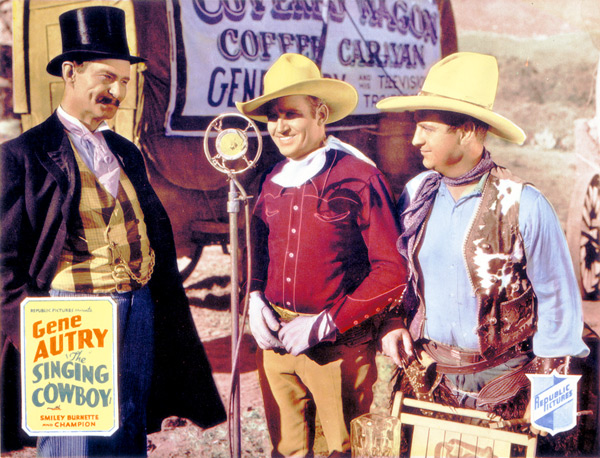
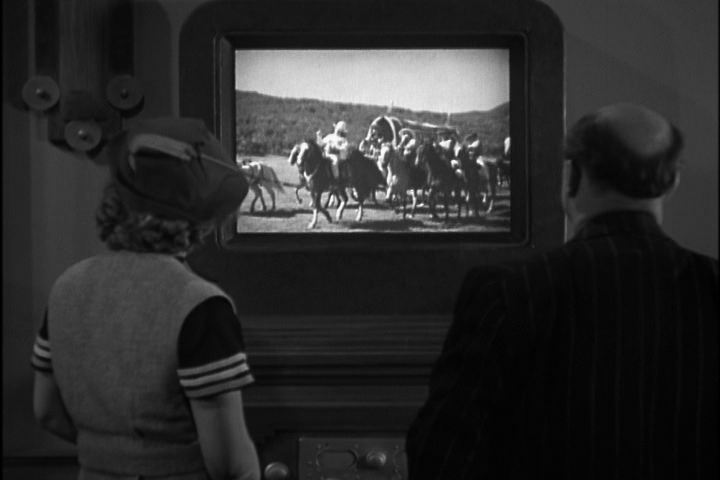
Review: Variety, Nov. 25, 1936
https://theautry.org/programs/film/singing-cowboy-loaded-pistols
http://www.imdb.com/title/tt0028256/
Undersea Kingdom
(1936, Republic Pictures, US) dirs. B. Reeves Eason and Joseph Kane
US release: May 30, 1936
Adventure serial about a quest for the lost continent of Atlantis, which features the tyrant leader of the Atlanteans using television technology as a surveillance system.
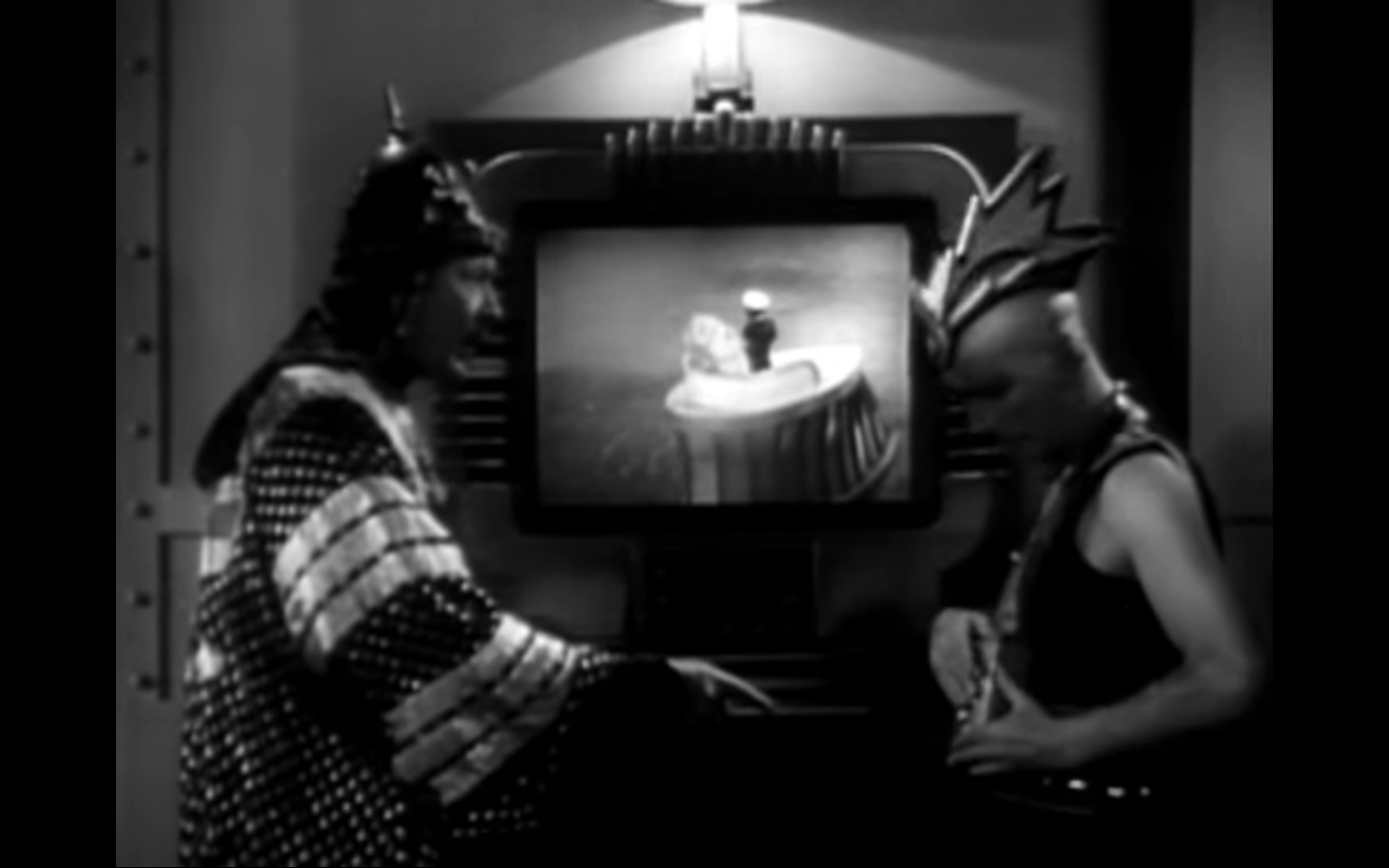
Review: Motion Picture Herald, May 16, 1936
VIDEO: https://www.youtube.com/watch?v=CU1ZGuRdaUk
http://www.imdb.com/title/tt0028444/
Trapped by Television
(1936, Columbia Pictures, US) dir. Del Lord
US release: June 15, 1936
"[T]he story of a young inventor who perfected a television method, what happens to him when he tries to market it, also what happens and how to the crook who tries to steal the invention" (Motion Picture Herald, May 23, 1936: 27). As another review noted, "it is difficult to envision a radio broadcasting company struggling for television equipment when the current factual battle is to get enough coin to make the invention commercially feasible" (Variety, June 7, 1936).

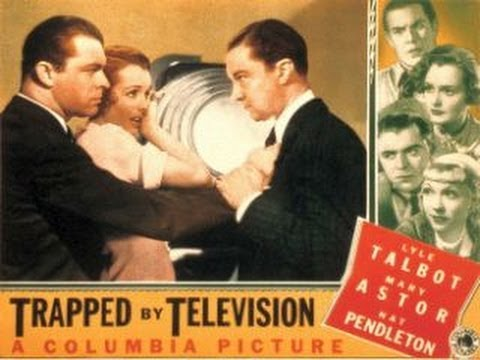
Reviews: Variety, June 7, 1936; New York Times, June 15, 1936; Harrison's Reports, July 4, 1936
VIDEO: https://www.youtube.com/watch?v=3Cp-l1gJilo
http://www.imdb.com/title/tt0028405
Fredek uszczęśliwia świat / Happy Freddy
(1936, Varsowia-Film, Poland) dir. Zbigniew Ziembinski
Poland release: Sep. 16, 1936
Polish musical about a young inventor who creates an attachment to the telephone that allows you to see the person you are talking to. This only works one way, so it results in many embarrassing scenes being uncovered. Problems ensue. Will the government take action against this violation of privacy? Also, a televisual unveiling of infidelity, much like in the 1912 Amour et science, troubles the young inventor's love life. At the end, they sell off the invention to all the people whose improprieties they have been uncovering.
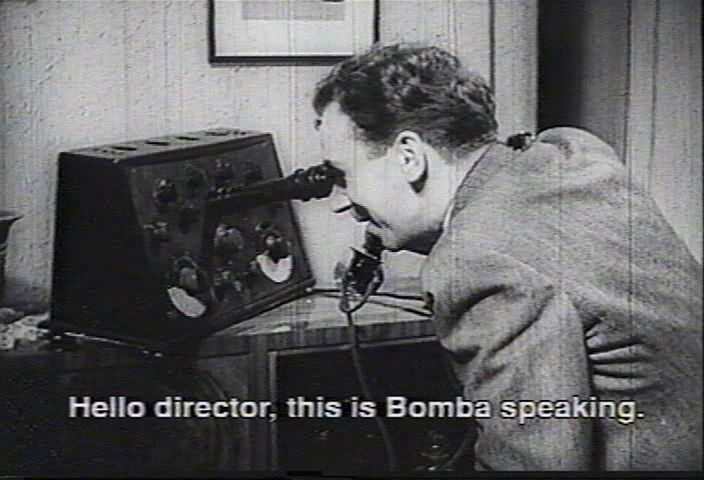

http://www.nitrofilm.pl/strona/lang:en/filmy/film_info/12/fredek-uszcz-liwia-wiat.html
http://www.filmpolski.pl/fp/index.php?film=22471
VIDEO: https://www.youtube.com/watch?v=8V-mOogjYgo
http://www.imdb.com/title/tt0027643/
Television Highlights
(1936, Mentone Productions-Universal, US) dir. Milton Schwarzwald
US release: Dec. 23, 1936
Musical short featuring a television set installed in a yacht club in New York, through which comedian Henny Youngman displays a series of vaudeville acts.
Reviews: Film Daily, Nov. 30, 1936; Motion Picture Daily, Dec. 2, 1936
http://www.imdb.com/title/tt0173319/
Television Romance
(1937, production company unknown) dir. [?]
Short film depicting "a delightful television broadcast in which all the characters are puppets" (Walter Gutlohn's "Entertainment Films 16mm Sound" catalog, 1940). Distributed in the US by Ideal.
Television Madness
(1937, production company unknown, US) dir. Otis Garrett
Futuristic short film, starring Billy Barty, Ruth Warren, and Hal Borne, depicting bandleader Hal Borne playing a duet with himself on television and a family watching an apartment house fire on TV discovering it is their own building that is burning (according to a description on a 16mm Em Gee Film Library catalog).
Bugs Beetle and His Orchestra
(1937, Terrytoons/Fox, US) dirs. John Foster and Paul Terry
US release: Jan. 21, 1937
Short musical cartoon about bugs attending a show at the Big Apple club (aptly located inside a big apple). A spider, who has been watching the event from his home by a radio-television apparatus, then shows up at the club and interrupts the entertainment.
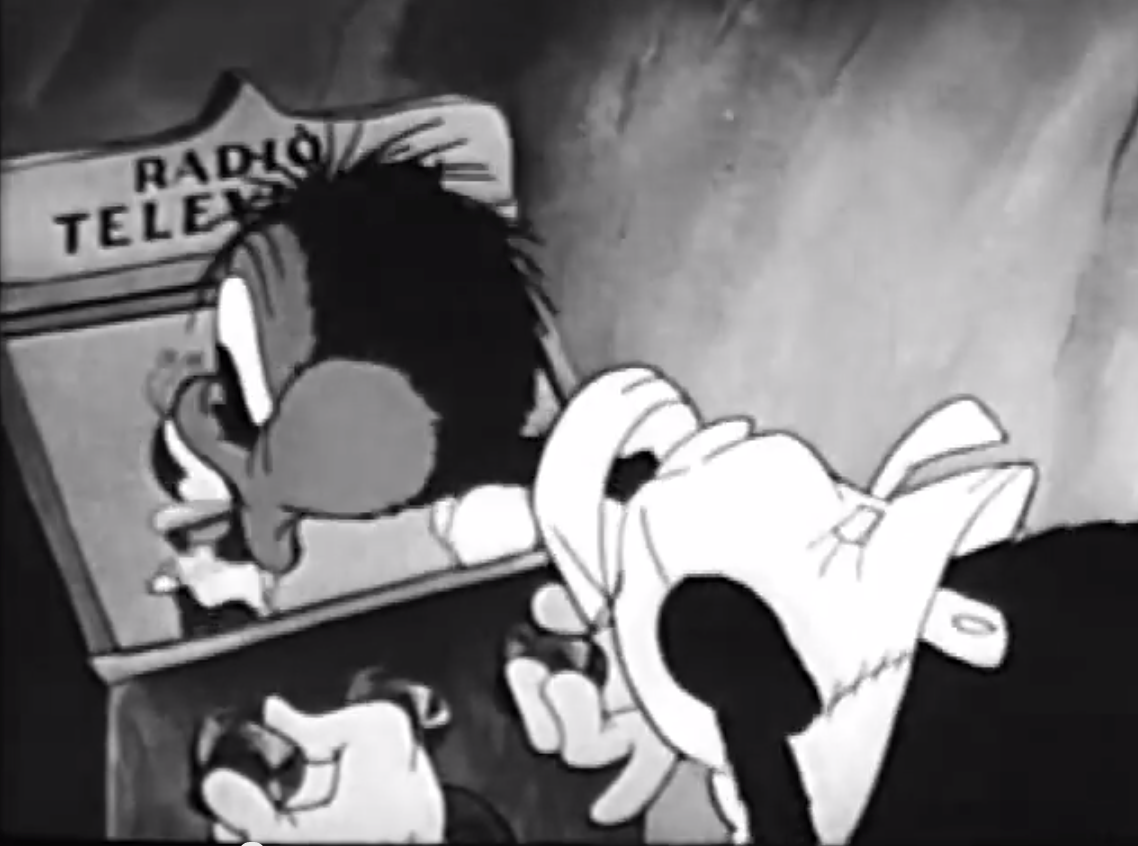
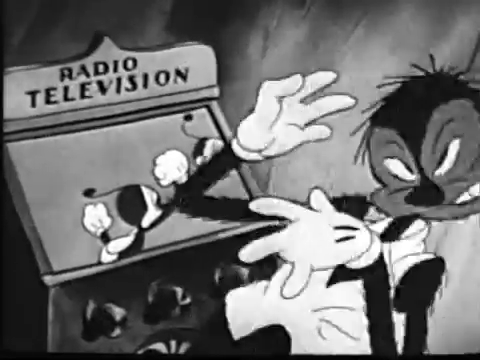
VIDEO: https://www.youtube.com/watch?v=JKJINeRC9WY
http://www.imdb.com/title/tt0149995/
Blake of Scotland Yard
(1937, Victory Pictures, US) dir. Robert Hill
US release: Jan. 30, 1937
Spy serial, also released as a feature film, revolving around an invention of a death ray that may bring an end to all wars, unless it falls into the wrong hands. The initial demonstration of the death ray's ability to destroy a ship in mid-sea is observed via a televisual "visual glass" system.

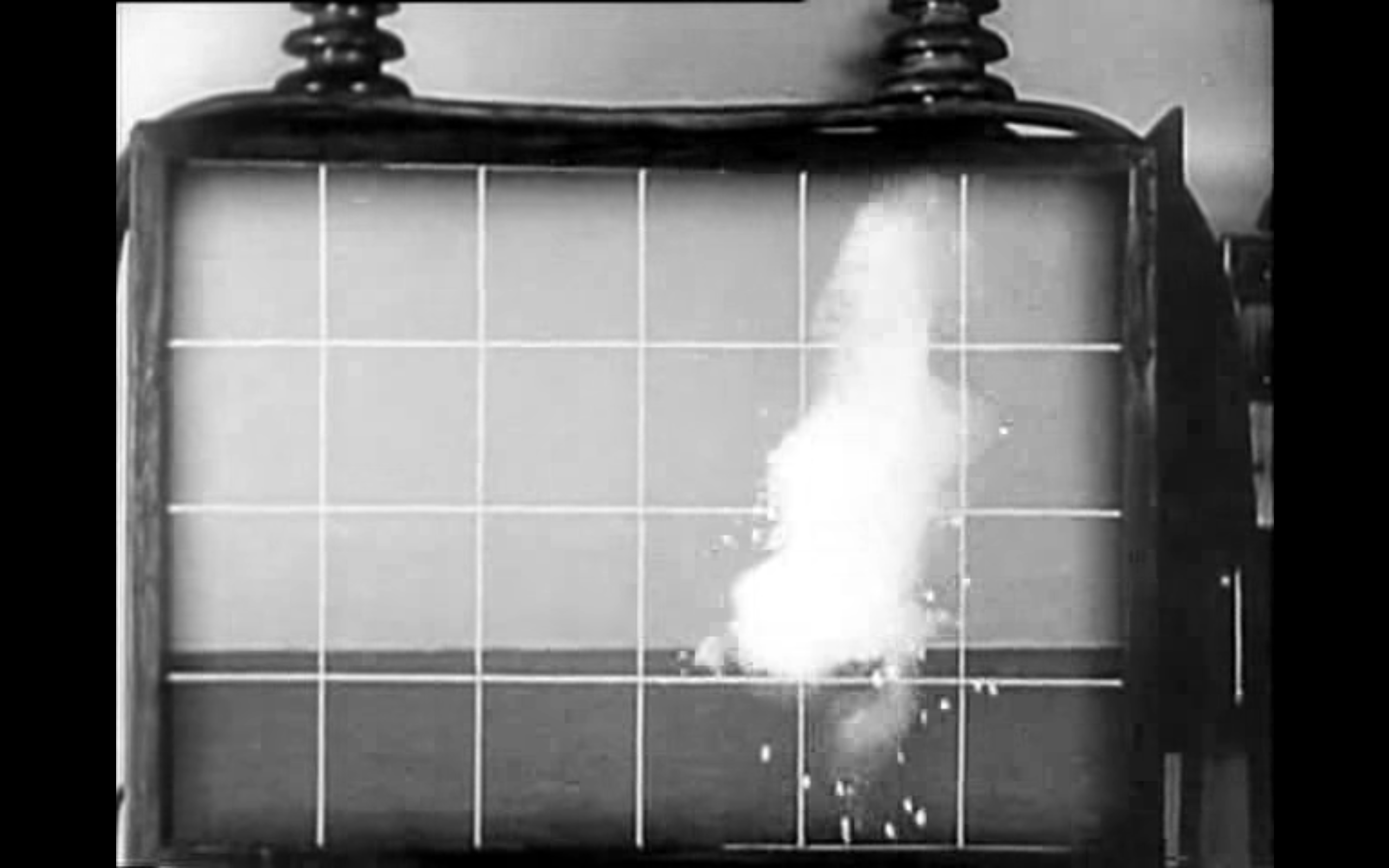
VIDEO: https://www.youtube.com/watch?v=Rb2SKSrocLM
http://www.imdb.com/title/tt0028637/ http://www.imdb.com/title/tt0126215/
Krazy's Race of Time
(1937, Screen Gems/Columbia, US) dirs. Manny Gould and Ben Harrison
US release: May 6, 1937
Short cartoon parody of the March of Time newsreel. In the "industrial utopia" of 1999, we see a large-screen television in a boardroom transmitting images from a factory.
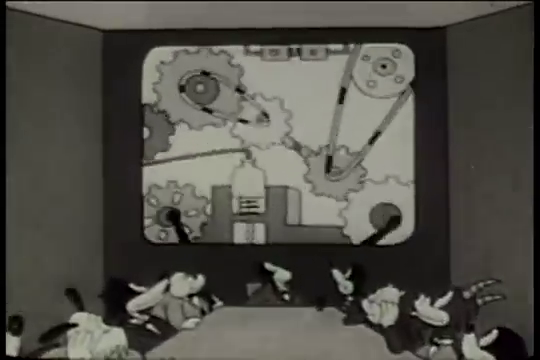
Review: Film Daily, June 3, 1937
VIDEO: https://www.youtube.com/watch?v=H-zmHgLrmuo
http://www.imdb.com/title/tt0151254/
Television Talent aka Television Trouble
(1937, Alexander Films, UK) dir. Robert Edmunds
UK release: Nov. 1937
A music teacher competes in a talent contest in which the winner gets to appear on television.
http://www.imdb.com/title/tt0169296/
La fessée / The Buttock
(1937, SPAF, France) dir. Pierre Caron
France release: Nov. 10, 1937
A husband spanks his wife in the midst of a domestic dispute, not knowing that an amateur cinematographer captures the moment on film. The footage is then broadcast on television by mistake and causes a scandal.
http://www.unifrance.org/film/5448/la-fessee
http://www.imdb.com/title/tt0192022/
Manhattan Merry Go-Round
(1937, Republic Pictures, US) dir. Charles F. Riesner
US release: Nov. 26, 1937
This musical follows a failing recording studio that has been taken over by gangsters who know little about show business. The studio's secretary shows her boss a "remote controlled short distance television set" on which he can view a musical performance.
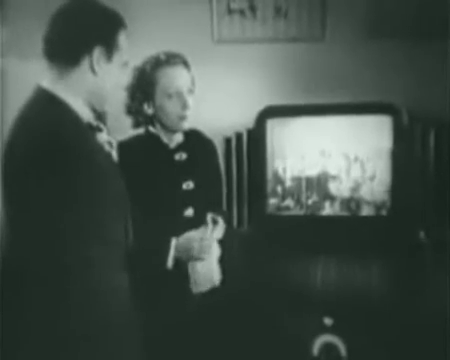
Reviews: Variety, Nov. 10, 1937; Film Daily, Nov. 11, 1937; New York Times, Dec. 31, 1937; Motion Picture Herald, Nov. 13, 1937
VIDEO: https://www.youtube.com/watch?v=kwr5nh4DpT4
http://www.imdb.com/title/tt0029209/
Bombs Over London aka Midnight Menace
(1937, Grosvenor Films, UK) dir. Sinclair Hill
UK release: Dec. 20, 1937
British drama about a newspaperman's attempt to stop a conspiracy to start a war. It depicts the use of picture-telephone apparatus, as well as a multi-screen control station from which the villains operate radio-control aircraft.

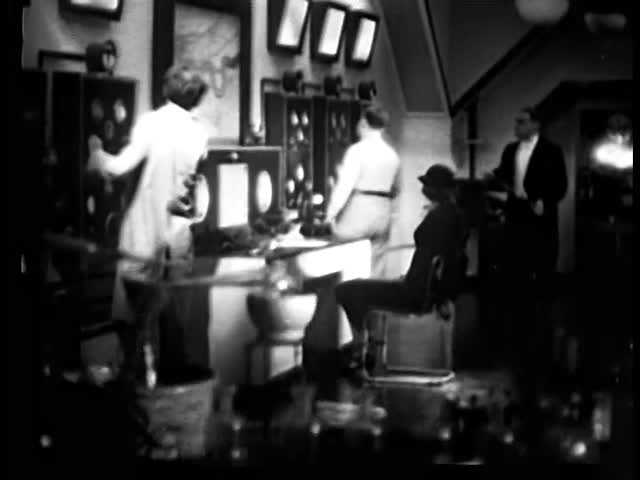
Review: Variety, July 14, 1937
VIDEO: https://www.youtube.com/watch?v=4RVAXnOB28c
http://www.imdb.com/title/tt0029240
Exiled to Shanghai
(1937, Republic Pictures, US) dir. Nick Grinde
US release: Dec. 20, 1937
Comic drama about the competition between newsreel cameramen and television cameramen. "Most newsreel stories are of rivalry among the cameramen, in obtaining exclusive pictures and in getting the pictures first on the theatres' screens. Here it is a newsreel company against the radio, wired-photos and eventually news by television. In the story the newsreel runs a poor fourth. The application of television here, incidentally, is beyond the wildest dreams of today's optimists, what with broadcasts from far away Shanghai to New York" (Motion Picture Herald, Dec. 18, 1937).
Reviews: Variety, Dec. 15, 1937; Film Daily, Dec. 13, 1937
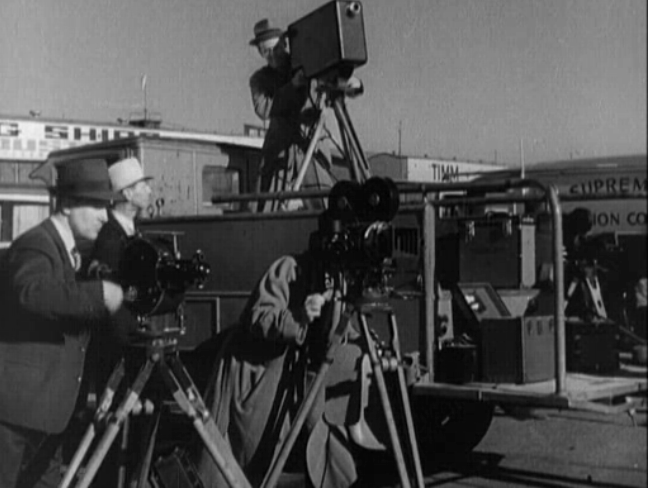
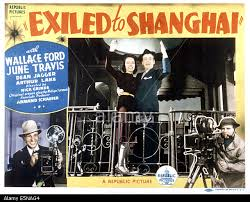
VIDEO: https://www.youtube.com/watch?v=xkHA7VgRYAw
http://www.imdb.com/title/tt0028845
Flash Gordon's Trip to Mars
(1938, Universal Pictures, US) dirs. Ford Beebe and Robert Hill
US release: March 21, 1938
In the second serial about the adventures of Flash Gordon, the comic-strip hero fights a Martian plot to destroy Earth's atmosphere. The serial, which was rereleased as a feature-length film under the title Mars Attacks the World in November 1938, features television devices installed in spaceships and caves to facilitate interplanetary communication.

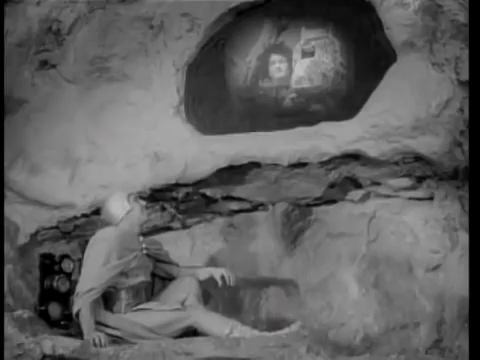
Review: Film Daily, Feb. 16, 1938
VIDEO: https://www.youtube.com/watch?v=calYW9xTPRI
http://www.imdb.com/title/tt0030138/
You Leave Me Breathless
(1938, Fleischer Studios, US) dir. Dave Fleischer
US release: May 27, 1938
Musical short, combining animation and filmed footage, with the music of Jimmy Dorsey and his orchestra. "The idea is to show what the television sets of the future will display. The cartoon skits cover some gags such as a shower-bath type street cleaning apparatus, a fountain of youth operating in Turkey, chill-proof over-coats for Eskimos, football player harnessed up with a stove, invention for a cow to mow a lawn and feed at the same time. Then the television set brings in Jimmy Dorsey and his band" (Film Daily, June 2, 1938: 4).
Review: Motion Picture Herald, July 2, 1938: 43
Hits and Bits of 1938
(1938, International Road Show, US) dir. [?]
US release: Sep. 1938 [?]
A race movie, consisting of various short musical episodes, including at least one featuring the Hampton University Choral Choir. According to a continuity script preserved in the New York State Archives and quoted by the AFI Catalog, an introductory title card reads, in part, "M-G-M gave us Broadway Melody of 1938, R-K-O gave us Radio Revels of 1938, Paramount gave us Big Broadcast of 1938. We, to be original, give you ‘Television of 1937 [sic].’ They tell us it's just around the corner ready for perfection. The same proverbial corner that prosperity is hiding behind. Let's take a look around that corner and see what we can see—and hear."
http://www.afi.com/members//catalog/AbbrView.aspx?s=&Movie=2254
http://www.imdb.com/title/tt0364412/
On Velvet
(1938, Associated Independent Producers, UK) dir. Widgey R. Newman
UK release: Sep. 26, 1938
Musical comedy about the foundation of a television advertising company.
http://www.bfi.org.uk/films-tv-people/4ce2b7516193c
http://www.imdb.com/title/tt0148549/
Five of a Kind
(1938, Twentieth Century Fox, US)
US release: Oct. 14, 1938
Starring the Dionne Quintuplets, this comedy of two rival radio reporters concludes with a performance by the quintuplets that takes place in Canada and is transmitted to a new theater, thanks to the "American electric company and their recently perfected television system."
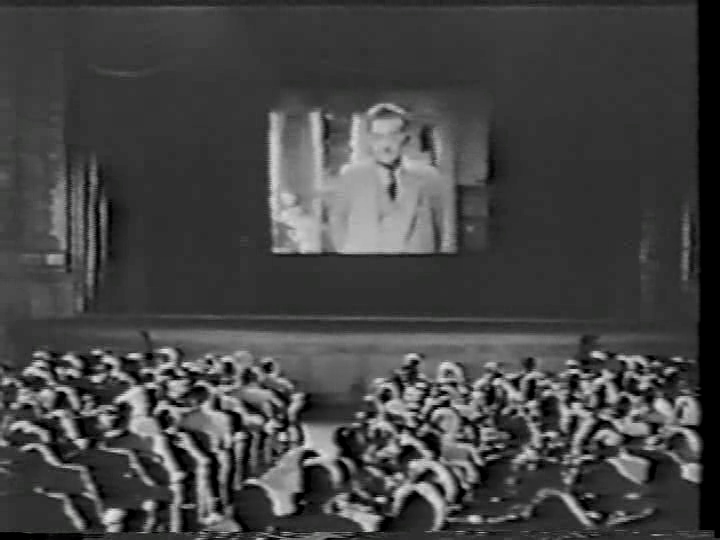
Reviews: Variety, Oct. 12, 1938; New York Times, Oct. 31, 1938; Hollywood, Aug. 1938: 16–17, 57–58; Harrison's Reports, Oct. 22, 1938
VIDEO: https://www.youtube.com/watch?v=va7_1A682Rg
http://www.imdb.com/title/tt0030136
Wer fuhr IIA 2992? / Who Drove IIA 2992?
(1939, UFA, Germany) dir. Karl G'schrey
Germany release: 1939
Short film made for the German Reichspost in order to inform the public about television. It uses a documentary-like depiction of a police investigation of a hit-and-run accident that makes use of television to broadcast forensic evidence and identify a suspect.
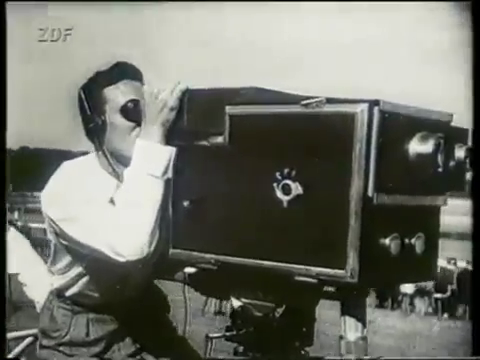
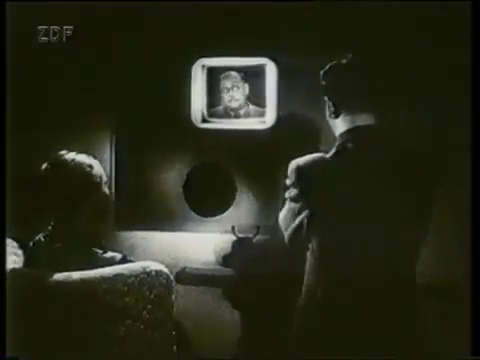
VIDEO: https://www.youtube.com/watch?v=sKXSZVLUvK4
http://www.fwm-stiftung.de/movie/5380
http://www.imdb.com/title/tt0380813/
The Middleton Family at the New York World's Fair
(1939, Audio Productions Inc. US) dir. Robert Snody
Feature-length promotional film, in Technicolor, sponsored by Westinghouse. A family from Indiana visits the 1939 World's Fair (mainly the Westinghouse pavilion) and attends a television studio demonstration.
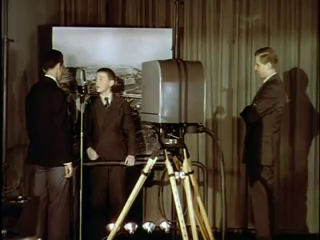
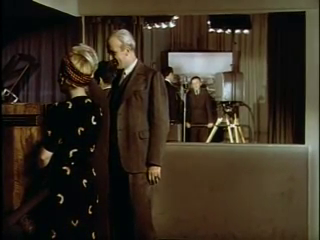
Review: Film Daily, Oct. 3, 1939
VIDEO: http://youtube.com/watch?v=YF594h8KUXw
http://www.imdb.com/title/tt0031645/
Mille lire al mese / One Thousand Lire Per Month
(1939, Italcine, Italy) dir. Max Neufeld
Italy release: Jan. 1939
A "white telephone" comedy of errors about an electrical engineer who moves to Budapest to start a new job in a television station, but very quickly has an unfortunate clash with the director of the station.
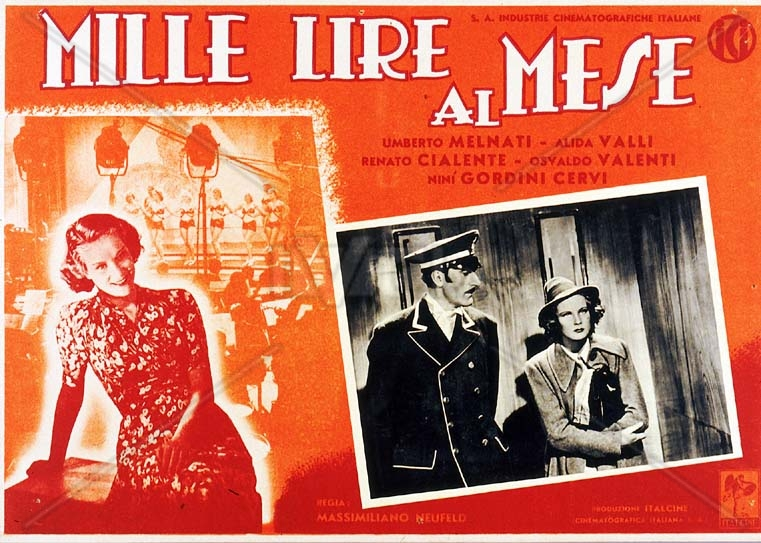

http://www.cinematografo.it/cinedatabase/film/mille-lire-al-mese/3046/
http://www.imdb.com/title/tt0030450/
Batticuore / Heartbeat
(1939, Era Film, Italy) dir. Mario Camerini
Italy release: Jan. 16, 1939
Satirical melodrama about a young woman who, after finishing thieves' school, is caught red-handed by a well-to-do ambassador. During a scene in which the two visit an embassy, they witness a demonstration of a television broadcast that gets scrambled and results in a series of comical images.
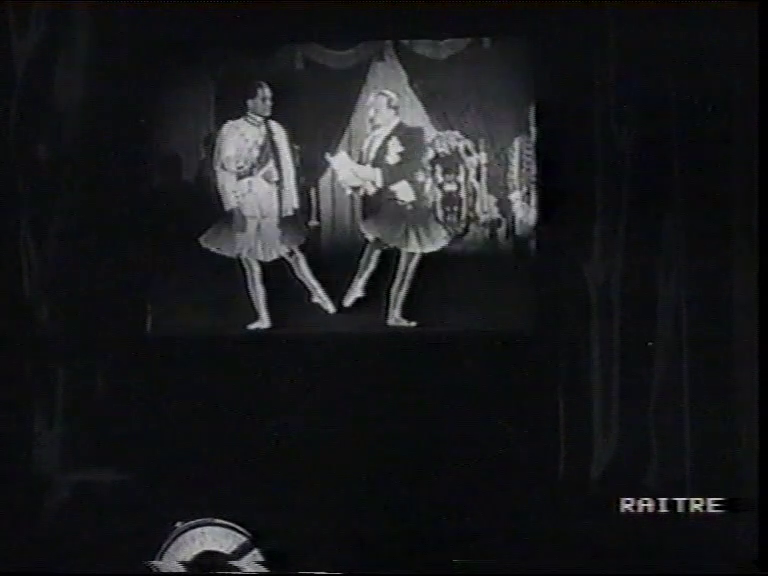
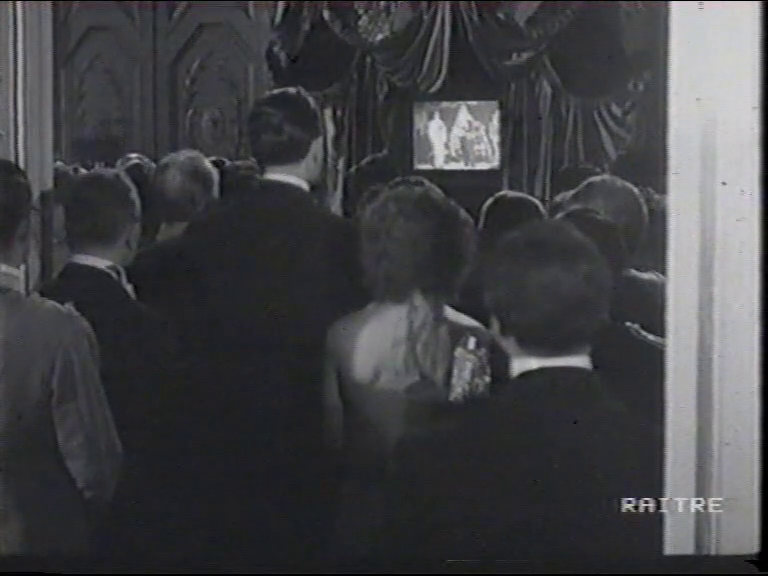
http://www.cinematografo.it/cinedatabase/film/batticuore/368/
http://www.imdb.com/title/tt0031085/
Buck Rogers
(1939, Universal Pictures, US) dirs. Ford Beebe and Saul A. Goodkind
US release: Apr. 11, 1939
Serial version of the adventures of a pilot who finds himself in the 25th century. Rogers teams up with the representatives of an oppressed future society who struggle against a tyrannical ruler equipped with a television surveillance system.
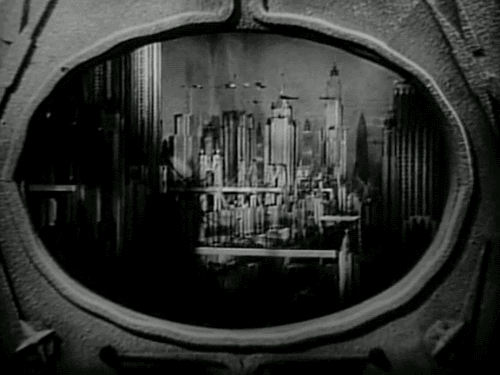
Review: Motion Picture Herald, Feb. 11, 1939
VIDEO: https://www.youtube.com/watch?v=iTtc-u3zFGk
http://www.imdb.com/title/tt0032290/
S.O.S. Tidal Wave
(1939, Republic Pictures, US) dir. John H. Auer
US release: June 2, 1939
A television reporter and his friend the television ventriloquist discover incriminating evidence about a corrupt politician. Apparently inspired by the 1938 Orson Welles "War of the Worlds" radio broadcast, the politician attempts to distract voters on election day by telecasting a false news report of the destruction of New York City in a tsunami (footage lifted from the 1933 RKO film Deluge).
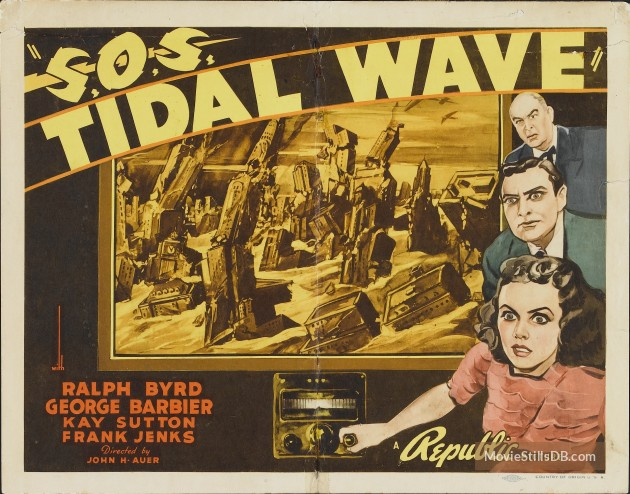
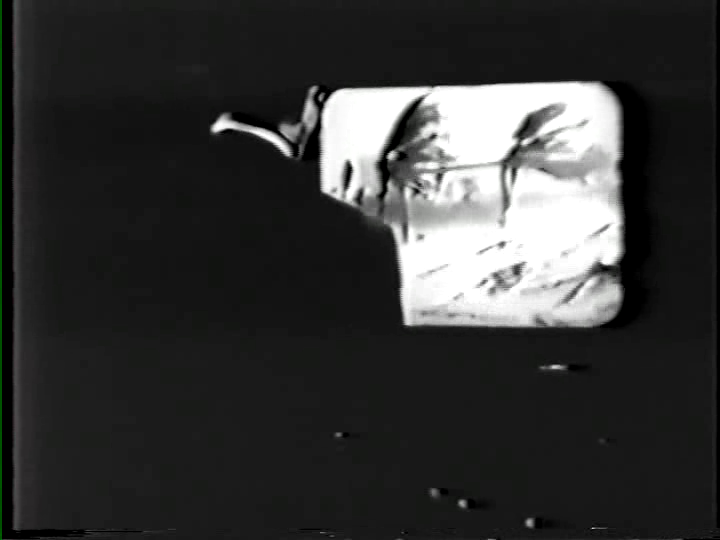
Reviews: Variety, June 21, 1939; New York Times, June 22, 1939; Film Daily, June 2, 1939: 6; Motion Picture Daily, May 29, 1929; Motion Picture Herald, June 3, 1939: 36
http://www.imdb.com/title/tt0031886
The Phantom Creeps
(1939, Universal Pictures, US) dirs. Ford Beebe and Saul A. Goodkind
US release: Oct. 17, 1939
Adventure serial starring Bela Lugosi as a mad scientist. In his laboratory, a device that provides him advance warning from raids by law enforcement appears to be a closed-circuit television apparatus.
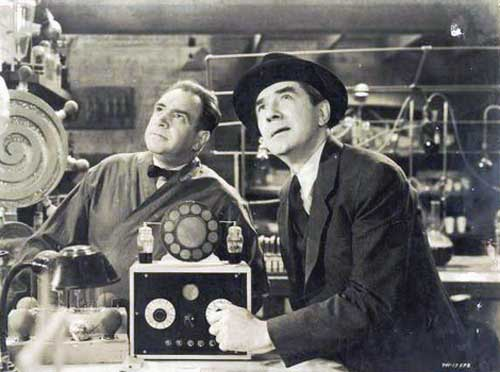
Review: Variety, Aug. 9, 1939
VIDEO: https://www.youtube.com/watch?v=gv5AUUGbaM4
http://www.imdb.com/title/tt0031796/
Television Spy
(1939, Paramount Pictures, US) dir. Edward Dmytryk
US release: Oct. 20, 1939
A rich patron sponsors a young inventor who constructs a television system, with the aim of perfecting it and then handing it over to the US government. At the same time, a group of spies attempts to get hold of the novel technologies.

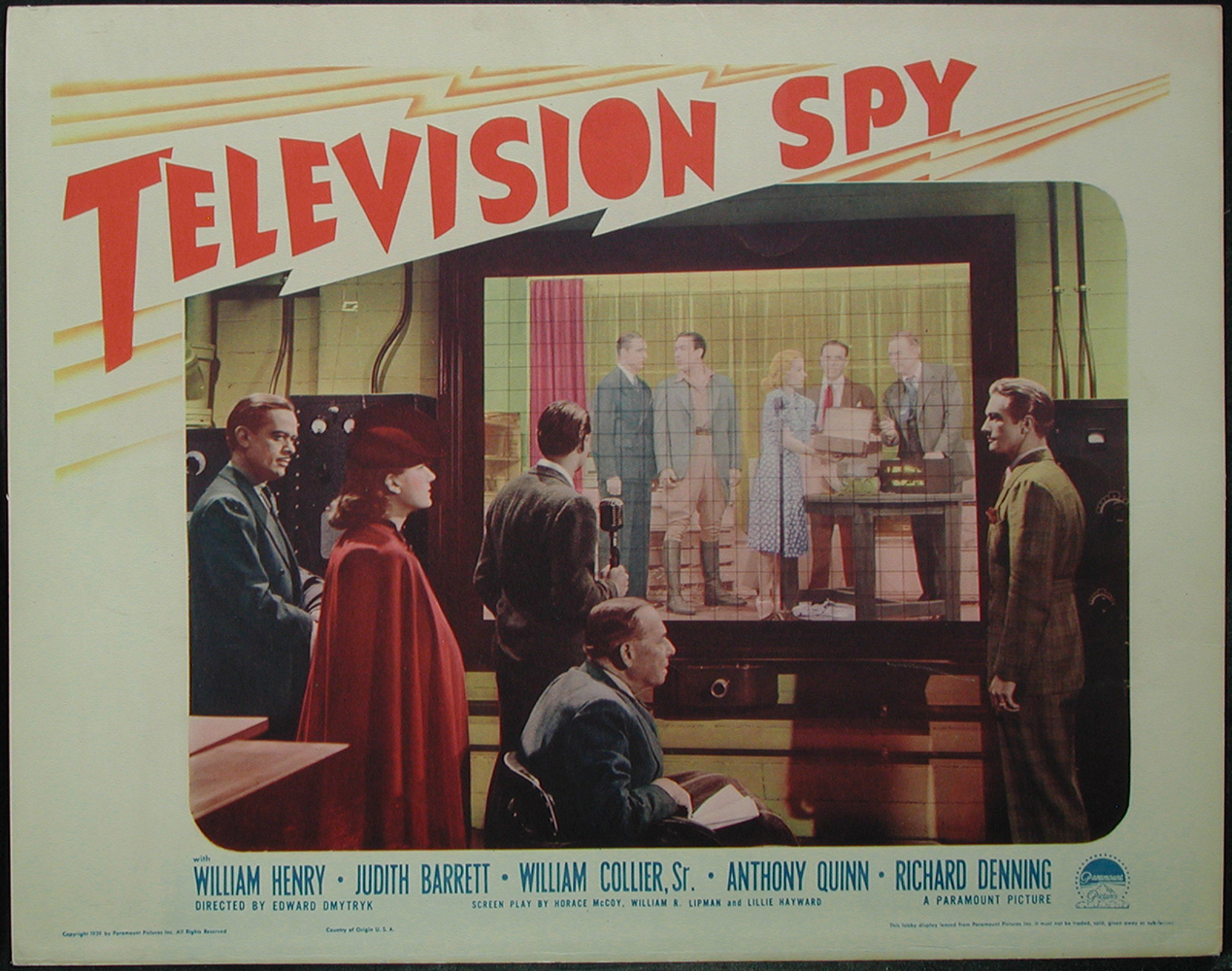
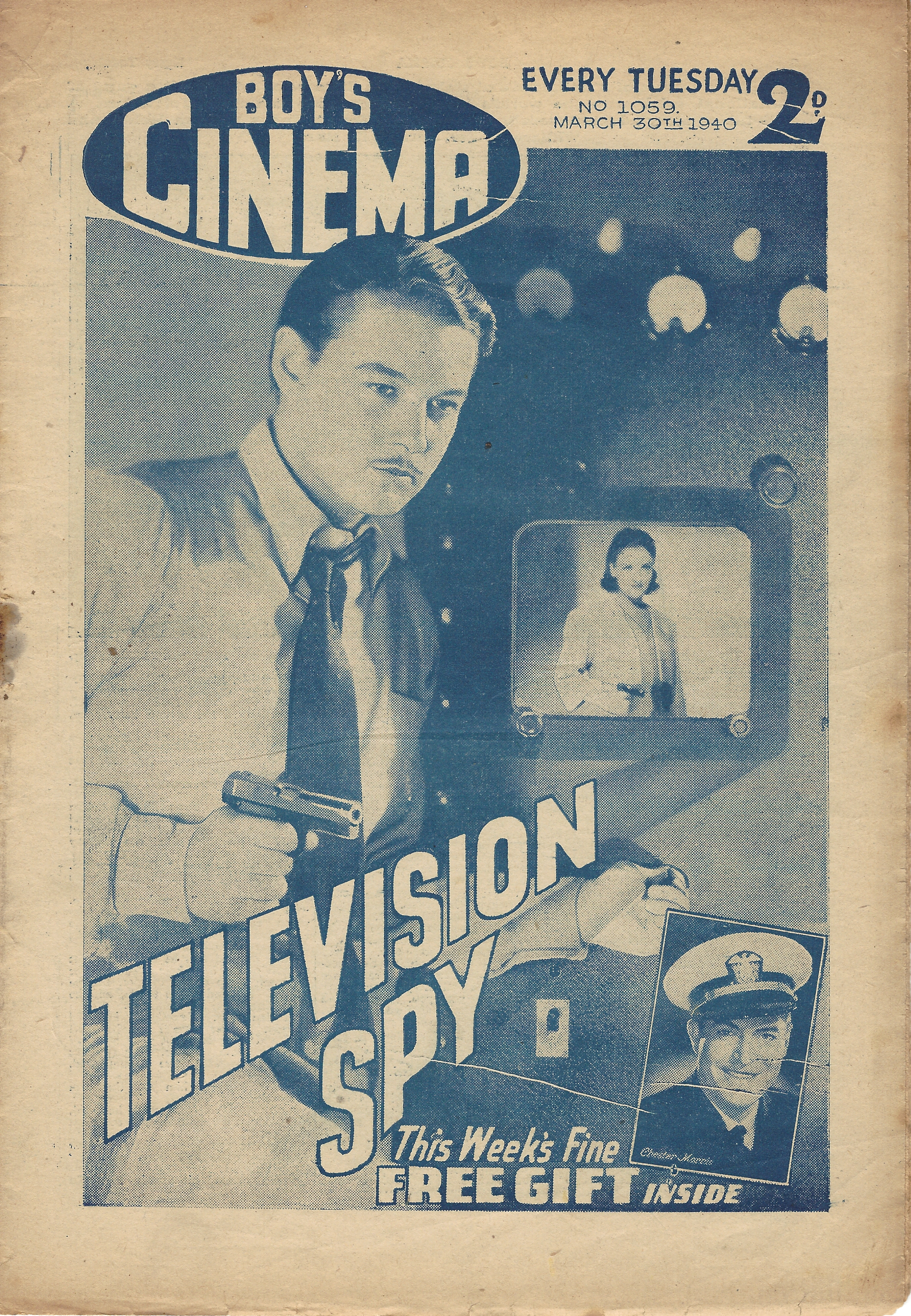
Reviews: Variety, Nov. 22, 1939; Film Daily, Oct. 13, 1939; Motion Picture Herald, Aug. 5, 1939
http://www.imdb.com/title/tt0032009/
Acknowledgments
For invaluable help in compiling the database, the authors would like to thank Nicholas Baer, Geoff Brown, Hannah Frank, Oliver Gaycken, Ron Gregg, Boaz Hagin, Diane Lewis, Katharina Loew, Trond Lundemo, Johan Nordström, Jan Olsson, Christina Petersen, Matthew Solomon, Yuri Tsivian, Julie Turnock, Johannes von Moltke, and Alberto Zambenedetti.
Readers are invited to suggest additional titles, illustrations, and links to online resources. Please visit the webpage http://www.dorongalili.com/television-in-the-cinema-before-1939/ to do so.
About the Author
Richard Koszarski is professor of English and cinema studies at Rutgers University. He was editor-in-chief of Film History from 1987 to 2012. His recent books are Fort Lee, the Film Town (Indiana University Press, 2004) and Hollywood on the Hudson: Film and Television in New York from Griffith to Sarnoff (Rutgers University Press, 2008). He is currently writing the next volume in the history of east coast cinema.
Doron Galili is a Riksbankens Jubileumsfond research fellow in the Department of Media Studies at Stockholm University. Previously, he taught at the Cinema Studies Program at Oberlin College, He holds a PhD in Cinema and Media Studies from the University of Chicago and his dissertation, “Seeing by Electricity: The Emergence of Television and the Modern Mediascape, 1878–1939,” received an honorable mention for the SCMS dissertation award.
